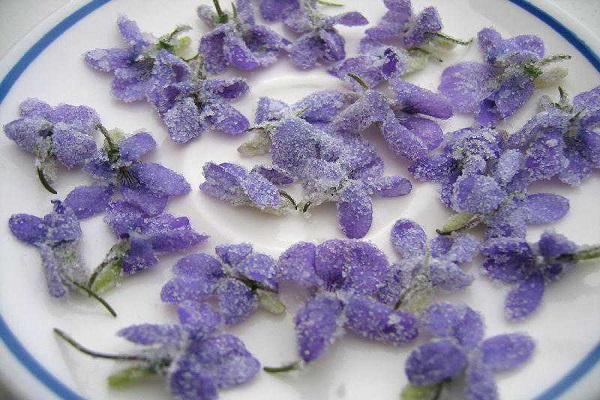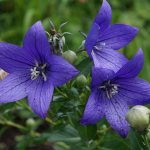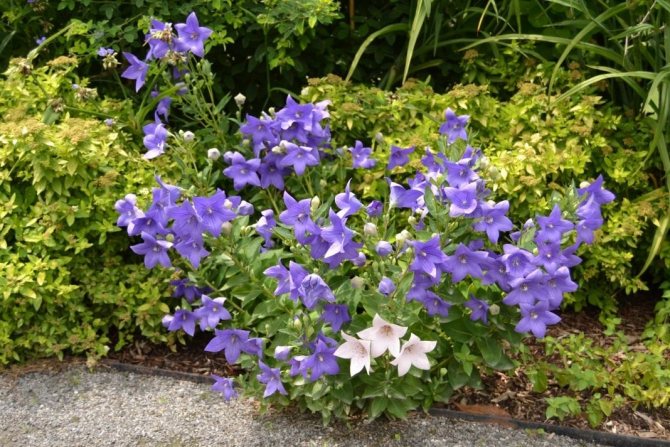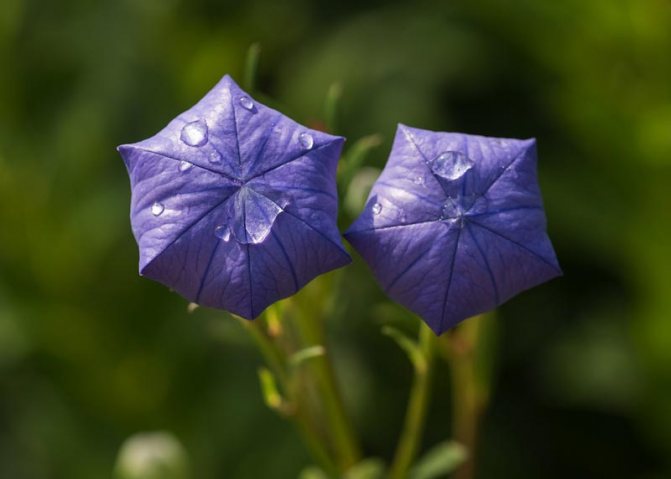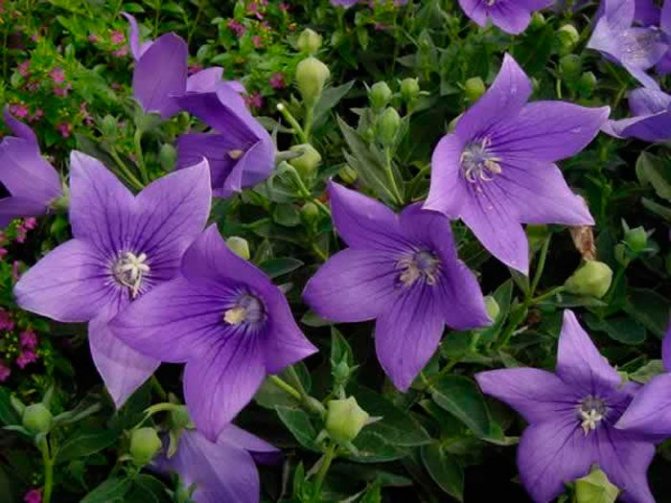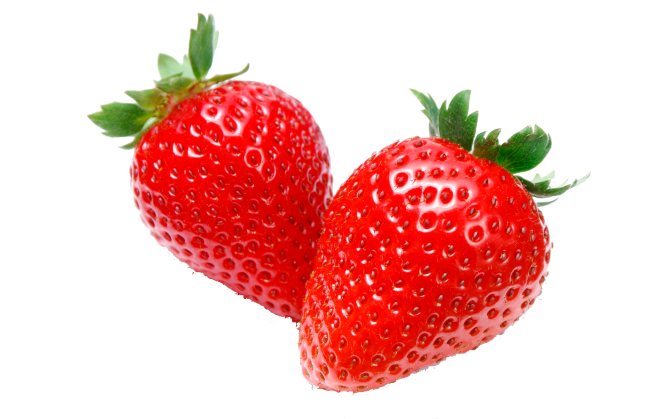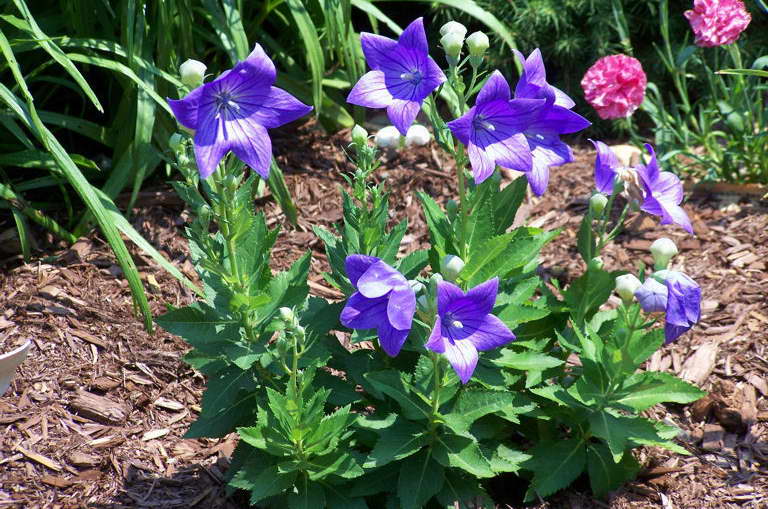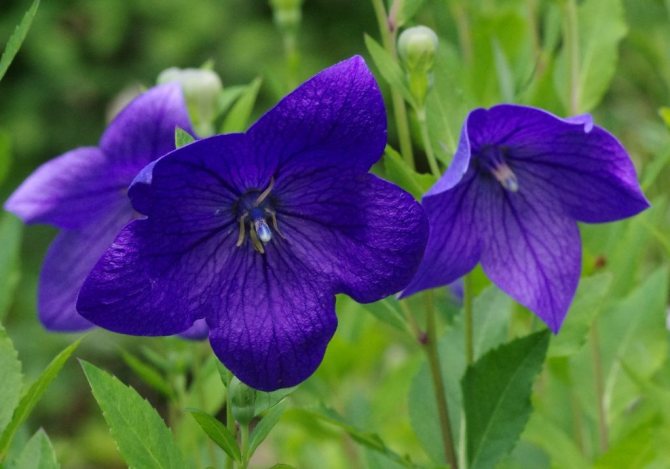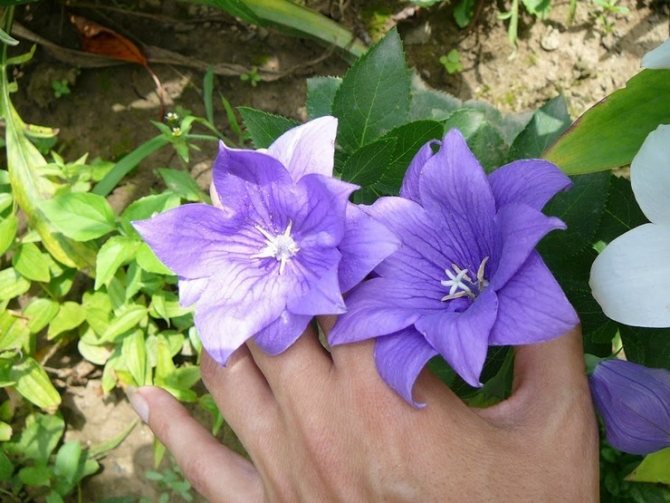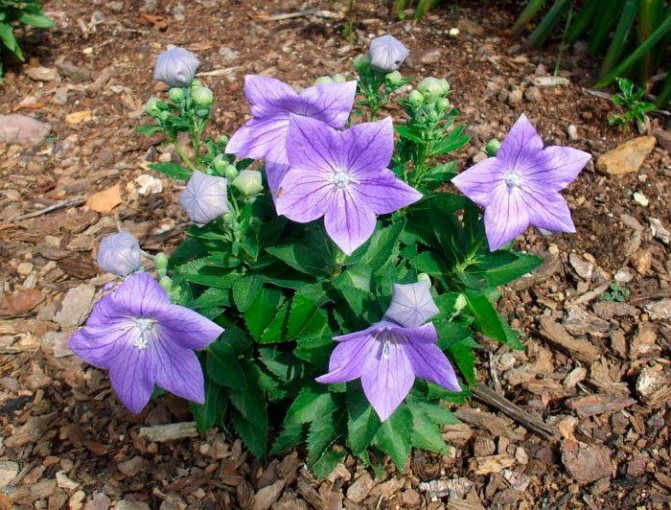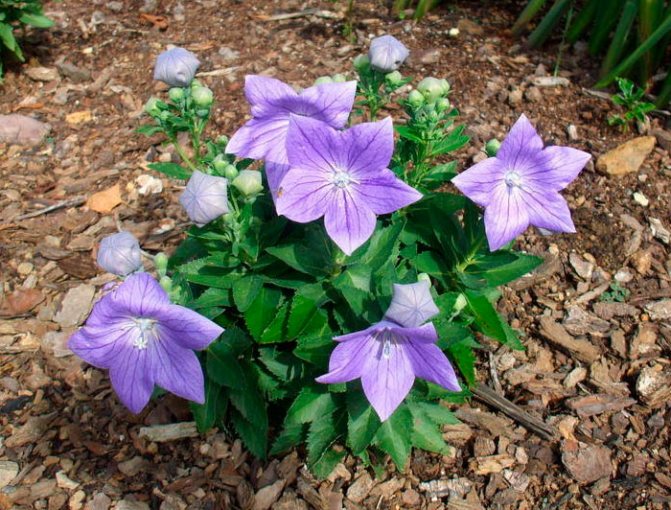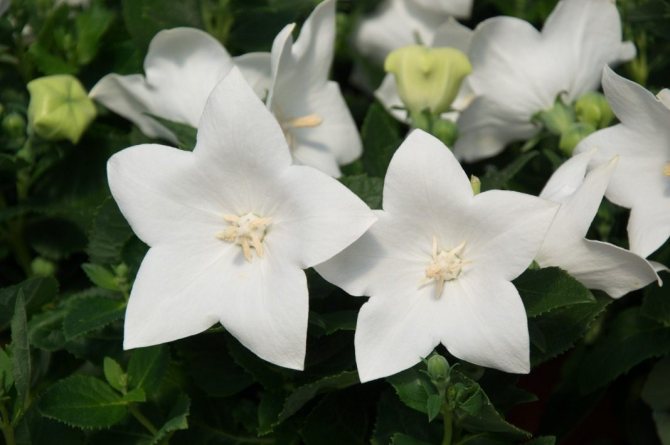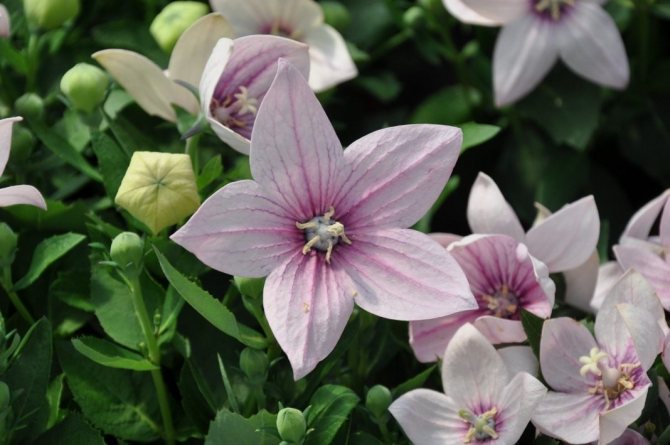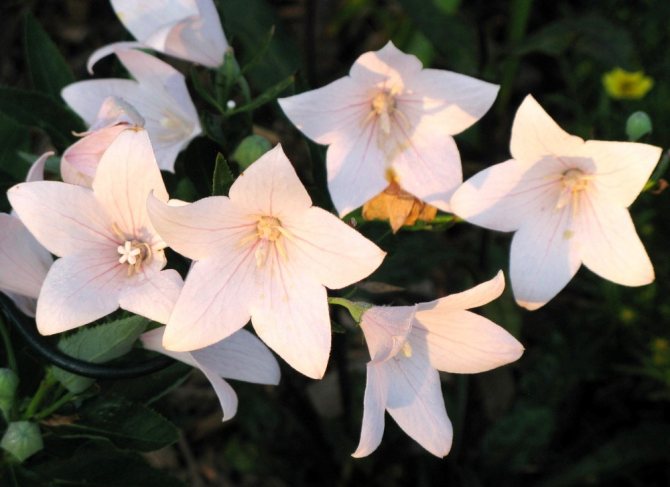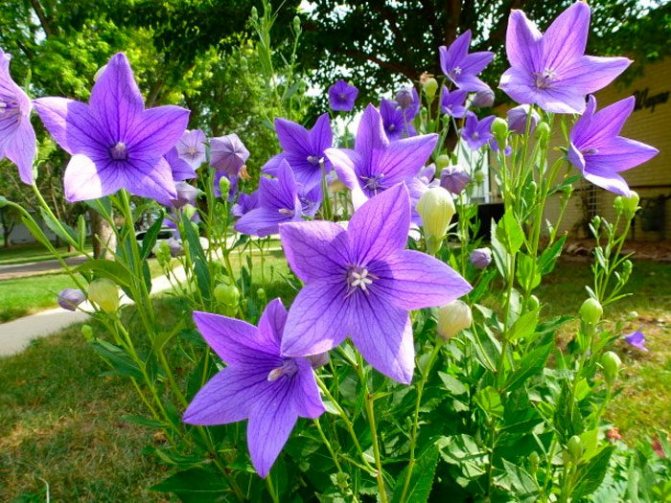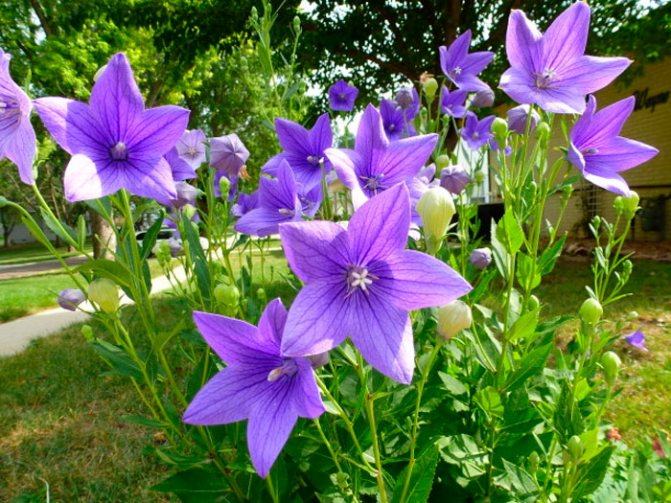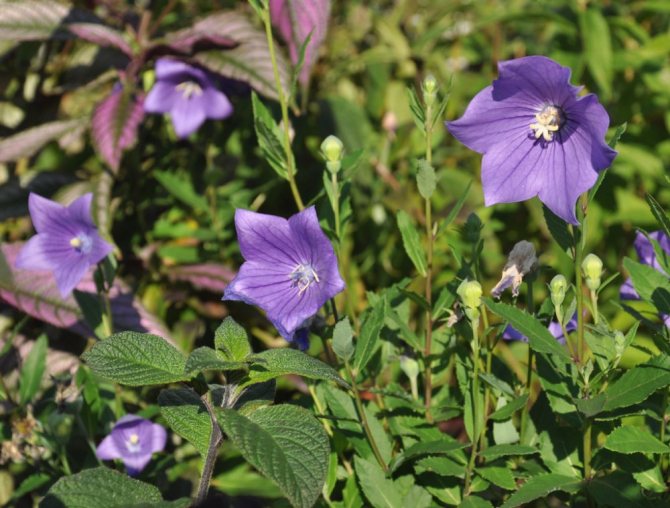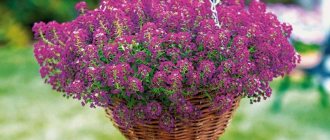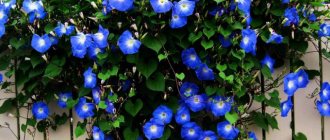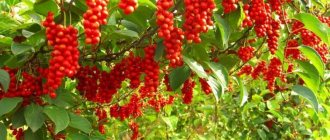Platicodon: planting and care in the open field, growing from seeds
Such a herbaceous perennial plant as Platycodon, also called shirokokolokolchikom, is a member of the bellflower family. The flowers of these plants look like large, wide bells. In nature, they can often be found in Eastern Siberia, China, the Far East, as well as in Korea and Japan. Platycodons prefer to grow on forest edges, rocky slopes and forest glades. The name of such a plant comes from the Greek language, and it consists of the words "platys" - "wide, even" and "kodon" - "bell". This genus is monotypic, because it includes only 1 species - platycodon grandiflorus, or large-flowered bellflower (sometimes confused with broadleaf bellflower). This species has been cultivated since 1872, but this flower gained popularity among gardeners only at the beginning of the 20th century.
Growing at home
Shirokokolokolchik can be grown not only in the summer cottage, but also at home on the windowsill.
The procedure is the same as for preparing seedlings from seeds, but the following factors should be taken into account:
- Place on a windowsill, not quite on the sunny side, so as not to burn the leaves.
- Periodically loosen the soil in the pot.
- Water only when the ground is dry.
- Feed in early July before flowering.
- In winter, water less often and move the pot to a room where the temperature is + 13 ... + 15 ° C.
Features of Platicodon
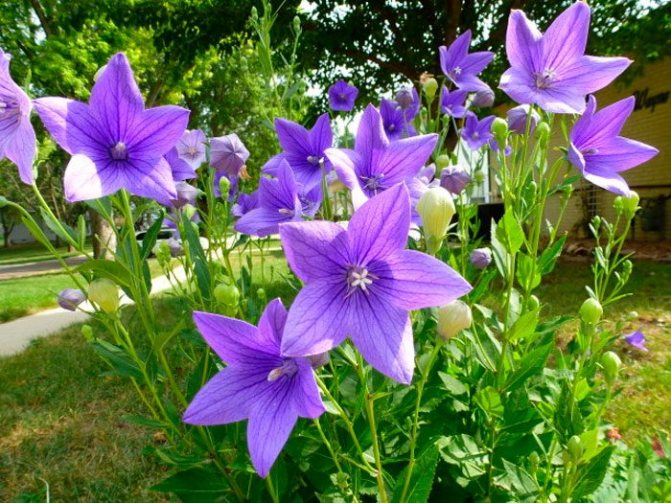
Platycodon's rhizome is fleshy, and the height of its straight, thin, densely leafy shoots can vary from 0.2 to 0.8 m. Opposite leaf plates have an elongated narrow or ovoid shape, as well as a finely toothed edge. The leaves located at the bottom are part of the root rosette. Leaf plates and shoots have a light bluish tint. Flowers can be single or 3-5 pieces collected in panicle inflorescences. The wide-open flowers are rather large, they can reach 8 centimeters in diameter, on the surface of the blue petals, a network is clearly visible, consisting of thin veins of dark color. There are forms, the color of the flowers in which can be white or dark purple. Externally, the swollen buds of such a plant are very similar to lanterns. Flowering lasts about 8 weeks and begins in the second half of July. The fruit is an ovoid capsule containing glossy flat egg-shaped seeds. It is recommended to grow such a flower in the garden together with a tall bell, gypsophila or undersized phlox.
Structural features
Platycodon is a genus of herbaceous plants from the Bellflower family. The only type of flower is a large-flowered shirokokolokolchik.Its natural habitats are in the Far East, Eastern Siberia, China, Japan and the Korean Peninsula. On the territory of Russia, the flower is included in the Red Data Books of several regions and is under state protection. Due to the economic development of territories, the predatory procurement of medicinal raw materials and collection in bouquets, the population of platycodons in nature is constantly decreasing.
The name of the species very accurately characterizes the appearance of a charming flower. It is a large, bowl-shaped bell, and at the bud stage it resembles a Chinese lantern. A hardy perennial with a long flowering period reaches a height of 80 cm. Platikodon is distinguished from other bell-shaped plants by beautiful, lush foliage with an even or finely toothed edge and a large flower - about 8 cm in diameter.
The root of the perennial is large, radish, up to several centimeters thick, and when it breaks down, it abundantly secretes milky juice. This part of the plant is used in the medical practice of many peoples; the description of the shirokolokolchik is present in the Pharmacopoeias of China and Japan.
Loading ...
From the root rosette of leaves, numerous leafy shoots rise, straight, smooth, branching from the very base. The color of the foliage, depending on the variety, can be from dark green to silvery-gray. The top of the stem is adorned with a panicle of 2–5 bell-flowers; a single flowering is less common. The petals fused at the base form a cup-shaped corolla and bend freely at the ends.
The opened flower looks like a regular five-pointed star with contrasting, voluminous veins. There are terry varieties in which the petals grow in several rows. Inflorescences of shirokokolokolchikov in nature are blue, but in cultivated form they acquired various shades. Snow-white, all shades of pink, blue, dark purple flowers attract the attention of gardeners and decorators not only for their beauty.
Plants are surprisingly unpretentious, they are easy to propagate, and in one place lush bushes can grow up to 10 years without transplanting. Abundant flowering begins in July and continues with equal intensity for about 60 days.
Growing Platicodone from seeds
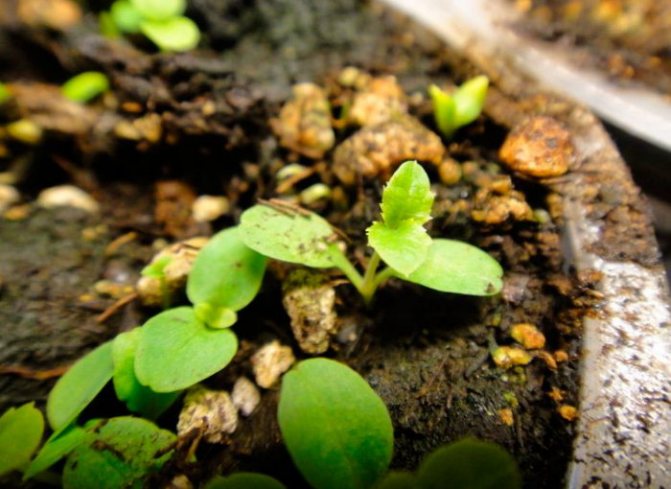

Sowing
Very often, gardeners choose the generative (seed) method for reproduction of Platycodon. Seeds can be sown directly into open soil in spring or before winter, but experts advise growing such a plant through seedlings. Sowing seeds for seedlings is recommended to be done in the last days of February or the first - in March. Before proceeding with sowing, the seeds must be prepared. To do this, they are poured into a bag of gauze and placed in a not very large vessel filled with water, where they must stay for two days. For sowing seeds, it is recommended to use large flowerpots or boxes, which must be filled with an earth mixture consisting of humus, peat soil and sand (1: 1: 1). The substrate must be well loosened, and then Platicodon seeds are laid out on its surface. There are 2 different opinions about embedding the seed in the ground, so, some of the gardeners claim that it is not necessary to bury the seeds, while the rest say that they need to be sprinkled with a thin (0.3 to 0.5 cm thick) layer of sand. When sowing is finished, the substrate should be moistened with water at room temperature using a spray bottle. Cover the container on top with a film, and then transfer it to a warm place (from 20 to 22 degrees). It is necessary to water the crops only after the top layer of the substrate dries up. The first seedlings should appear 7-15 days after sowing.
How to care for seedlings
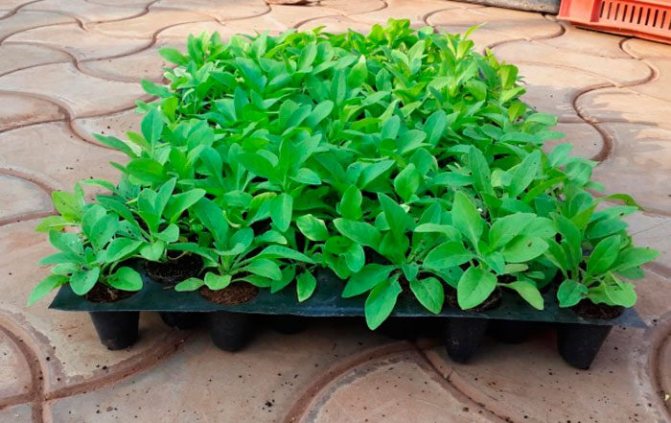

It is necessary to care for the growing seedlings of Platycodon in exactly the same way as for the seedlings of other garden flowers. When the first seedlings appear, the shelter must be removed, while the container itself is rearranged to a cooler place (from 18 to 20 degrees).Seedlings should be watered only when necessary. After each watering, be sure to very carefully loosen the soil in the container. After the seedlings have 3 or 4 true leaves, they will need to be picked into individual pots with a diameter of about 10 centimeters. Flowers will grow in these containers until they are planted.
How to plant platycodon seeds in the ground
- Platycodon seeds are sown in open ground in warm spring (end of April) or before winter (end of October).
- Cover from above with a layer of compost or sifted earth with a layer of two to three centimeters.
- This planting method gives results by the end of May. The first shoots may appear in late May, and more likely in early June.
- The flower slowly forms and blooms after one to two years.
- Seedlings need to be thinned several times, leaving a total of 20 cm between the bushes.
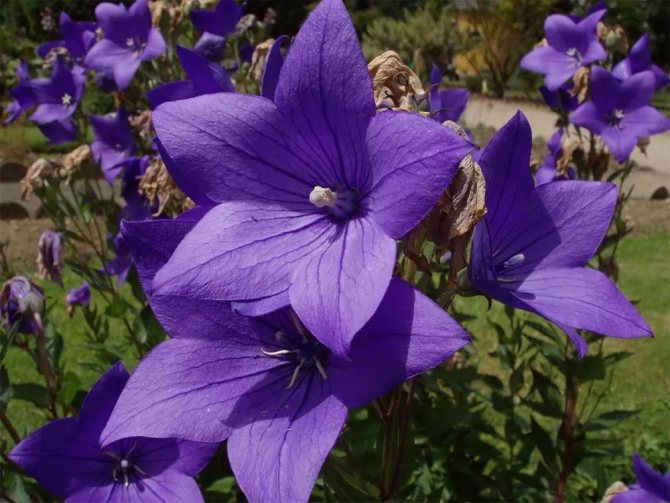

Planting Platicodon in open ground
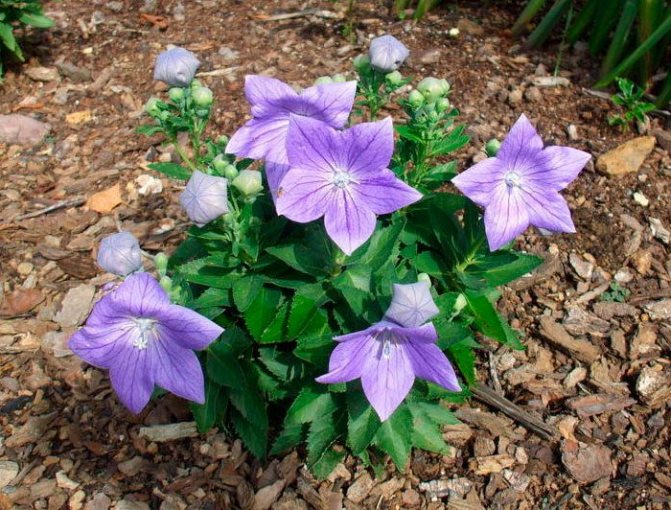

What time to plant
Platycodon seedlings should be planted in open soil in the last days of May or the first in June, when you are sure that the night frosts are over. For such a plant, it is recommended to choose a sunny area in the garden, but it can also grow and develop normally in partial shade. The soil should be not too wet, well-drained, loose and rich in nutrients. A loam with a low sand content and a neutral reaction is best suited for such a flower. In an adult bush, the root system is located vertically, in this regard, the groundwater at the site must necessarily lie deep enough. It should also be noted that Platycodon cannot be transplanted because its roots are very fragile. It can be grown in the same place for more than 10 years. Before planting seedlings, the site must be dug up, while adding fertilizer to the soil, so 1 large spoonful of complex mineral fertilizer and 0.5 tbsp are taken per 1 square meter. wood ash.
This is interesting: Morning glory flower - care and planting
Landing features
The size of the holes should only slightly exceed the volume of the seedling pots. The distance between them should be from 25 to 30 centimeters. Before planting, the plant must be watered abundantly. There are gardeners who recommend immersing the plant completely in water along with the pot before planting. Then the seedlings are carefully removed from the pot, and an earthen lump is lowered into the prepared hole, which is then covered with soil and compacted a little. The planted plants need watering.
Planting platycodon in the garden
It should be planted in the country at the end of May or in the first summer month, when there will be no night frosts.
The best place is neutral acidity soil with sand, charcoal and mineral fertilizer are added to the hole, as for ordinary garden flowers.
Loosen the soil before planting the sprout, the shirokokolokolchik gets along well in a permanent place for up to 10 years, preferably on the sunny side, but you can also plant it in partial shade. The main thing is that the groundwater does not lie close to the site, the roots of this plant reach 20-80 cm in length, it is not recommended to transplant the bell.
In the selected area, pits are dug, larger in diameter than the pot with seedlings, at a distance of 25 cm from each other. Seedlings should be well watered before planting, some advise to completely immerse the pot in water, then pull out the sprout along with the soil and place it in a dug hole, tamping the soil around. After planting all the plants, the flowers are watered.
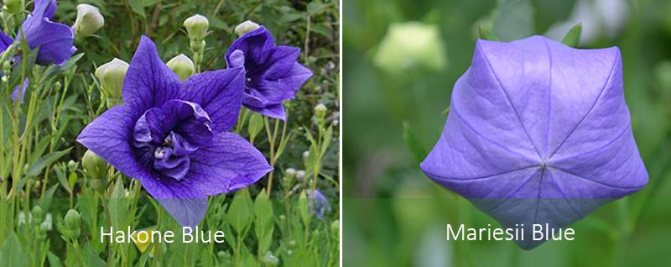

Platycodon care in the garden
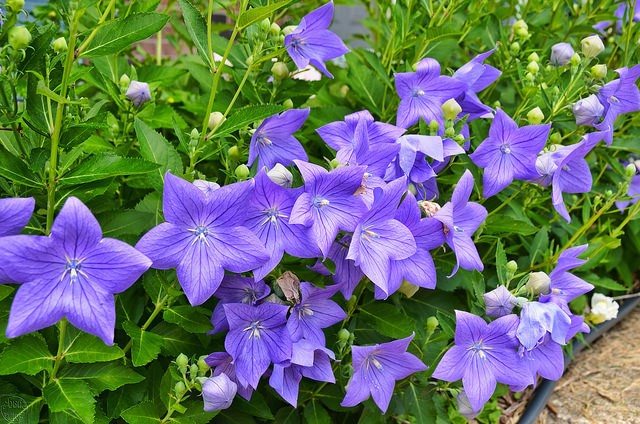

Seedlings just planted in open soil need systematic watering. It must be carried out every day for the first 14 days. Then the plants are watered no more than 1 time in three days and not so much water is poured onto one bush.When the platycodon is watered, it is necessary to loosen the surface of the soil and pull out all the weeds. To reduce the number of watering, weeding and loosening of the soil, it is recommended to cover it with a layer of mulch.
Also, this plant should be systematically fed once every 4 weeks with a complex fertilizer for flowering plants. These flowers have one feature, namely, they stretch up strongly, this becomes clearly noticeable after the bush turns 3 years old. In order to preserve the decorativeness of flowers, it is recommended that they regularly make pinches, or they can be treated in spring with a special preparation that slows down the growth of the plant (inhibitor), for example, you can use the Athlete. In the event that the platycodons are still strongly elongated, they will have to be tied to a support. You also need to remove the flowers that have begun to fade in time.
Reproduction of platycodon
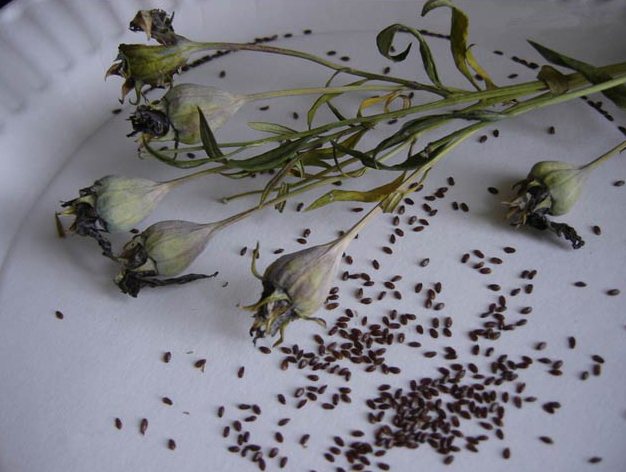

It is best and most reliable to propagate such a plant in a generative (seed) way. Some gardeners try to propagate Platycodon by cuttings, but only a few can do it. But if there is a desire, then of course, you can try to grow such a flower from cuttings. Cuttings are harvested in spring, for this it is necessary to cut off the stem with a pair of internodes, as well as with the heel. Then the cutting is planted for rooting as usual.
If the bush is grown on sandy soil, then for its reproduction, you can resort to dividing the bush. To do this, carefully dig up the flower, and then make a thorough examination. If you find shoots with buds, then they can be carefully cut off with a pre-sterilized sharp knife. Places of cuts should be treated with sulfur or ash, and then the cuttings should be planted in a permanent place in open soil. However, when propagating Platycodone vegetatively, you should be prepared for the fact that you will fail. The best and easiest way to grow this plant is from seeds.
Diseases and pests
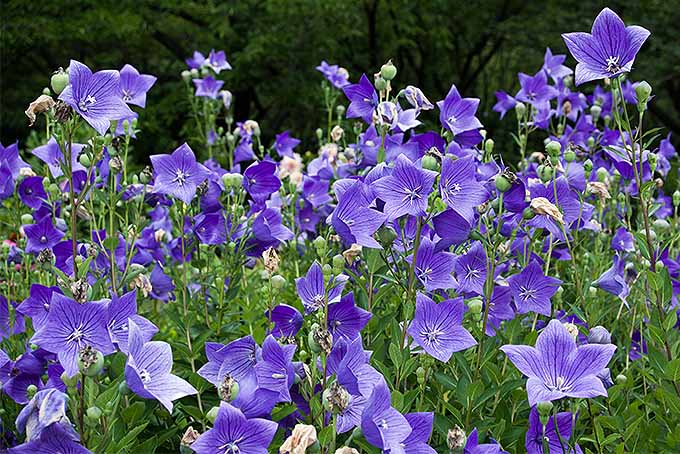

This plant has a very high resistance to a variety of diseases. However, if the weather is very wet for a long time, then there is a high probability of infection of Platicodone with gray rot. In order to avoid this, experts advise to thoroughly loosen the surface of the soil, as well as be extremely careful with watering, try to avoid stagnation of moisture in the root system of the plant. If the flowers have already begun to rot, then it is recommended to dig up and destroy the affected bushes, and the remaining ones must be sprayed with a solution of copper sulfate or Fundazol (2%) or Topsin-M (1%). After 1.5 weeks, it is recommended to spray the plants again.
Only rodents, or rather, moles and mice, can harm such a flower. They are able to injure his root system. There are a large number of methods that will help get rid of these pests, but which ones are suitable in your case, it's up to you. The most effective way is to "smoke" the rodents out of their houses. To do this, you need to connect a rubber hose to the exhaust outlet of the chainsaw. The other end of this hose should be placed in the burrow. While the chainsaw is running, smoke will begin to enter the hole, and the rodents will get to the surface. There is another way to get rid of pests. You will need to purchase bait with poisoned cereals and spread it around the site. It should be borne in mind that this method of rodent control does not work on moles.
Diseases and pests of platycodon
| Name | Signs | Elimination methods |
| Gray rot | It spreads throughout the plant due to a fungus that loves dampness (overflow and incessant rains). | 2 times after 10 days, the bush is treated with copper sulfate or Fundazol. Infected specimens are discarded. |
| Moles and mice | Rodents are capable of damaging the roots of Platicodon. | You can put poison for rodents around the site. It is more difficult to fight with moles, you need to insert a hose into their hole, connect the other end to the exhaust pipe of the car and turn on the chainsaw, only then this animal will run out of the hole. Another way to deal with moles is to make a rattle and put it on the site. It should also be remembered that they do not dig their holes in the ground where marigolds, garlic, euphorbia grow, and also if the ground is dry. |
| Slugs | They eat the leaves. | It is best to sprinkle ashes or eggshells on the soil, on which slugs cannot move. You can also bury a glass of milk or beer in the ground, or use a slice of grapefruit to get slugs into. |
Platicodon after flowering
Seed collection
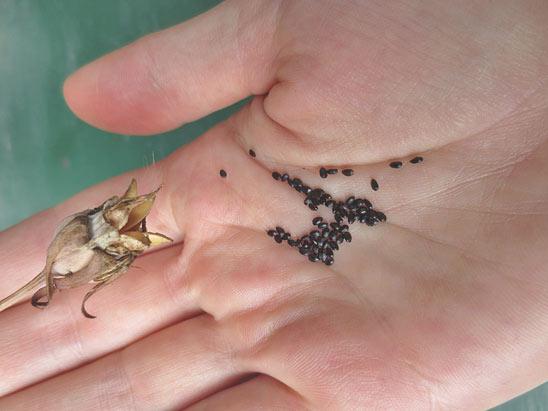

When the box inside the flower cracks, it will be possible to understand that the seeds are ripe. Seed collection is carried out only after the pedicels are completely dry (usually in September). Absolutely new varieties can grow from seeds collected with their own hands, while the flowers of such plants will have an unusual color.
Preparation for wintering
This flower is a perennial. In this regard, in autumn, its aboveground part must be completely cut off, and the surface of the site must be covered with a thick layer of mulch (humus, dried foliage, peat, sawdust or spruce branches).
Description and varieties
A plant with completely bare bluish stems, having a height of 40 to 120 cm. The rhizome is white fleshy, similar in shape to a radish. Rhomboid leaves with a drawn-out pointed tip and serrations along the edges sit alternately, Flowers are most often single, but occasionally they are collected in small inflorescences of 2-10 pieces of large flowers, which are located at the tops of the shoots. Flowers have a classic bell-shaped shape and reach 8 cm in diameter, can be simple and double. Wild platycodon is always blue in color. But breeders have bred varieties of white and pink flowers. Flowering occurs during the height of summer, in July and August. The fruit is an ovoid capsule consisting of 5 shiny dark denticles about 2 mm long.
There are dwarf and tall varieties, they can also differ in the shape of the flower and its color. They are all extraordinarily decorative. A striking feature of Platycodon is the inflation of the bud to a spherical state before opening. The buds look like bright colored lanterns.
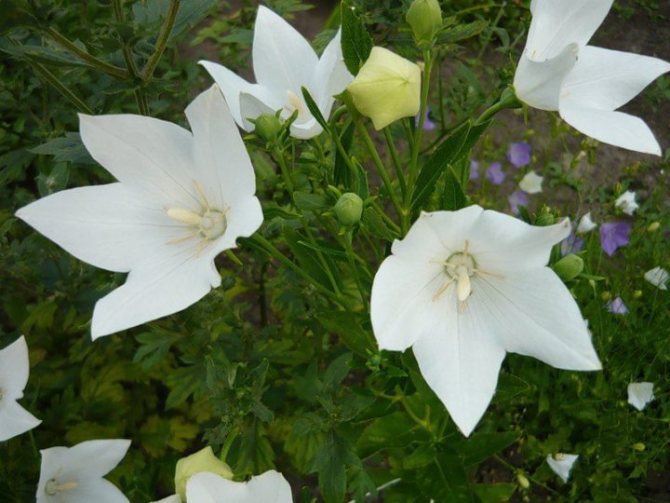

Consider the most popular and demanded varieties.
Album. A powerful shrub up to 0.8 m high with luxurious large white flowers, on the petals of which blue veins sometimes clearly appear.
Platicodon Astra Pink. A small plant no more than 20-25 cm in height with very large star-shaped single flowers of a pale pink color.
Astra Blue. Huge blue flowers with bright blue veins along the petals.
Double. Another variety of the Astra variety, has a double row of petals.
White. A compact small bush about 20 cm high with star-shaped delicate bright white flowers.
Shell Pink. The variety is quite tall - up to 0.8 m, the flowers are light pink.
Platycodon varieties with photos and names
As mentioned above, the Platycodon has only one species, but there are a great many different varieties. The most popular varieties:
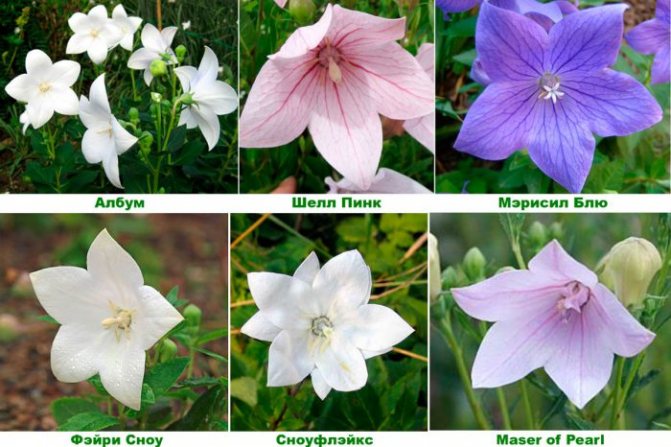

- Album ... A fairly common variety with erect shoots, the height of which can vary from 0.6 to 0.8 m. The diameter of white large flowers is 8 centimeters, while their surface can be streaked with thin veins of blue. Flowering is observed from the last days of June to August.
- Shell Pink ... Plant height is about 0.8 m, and large flowers are colored light pink.
- Marisil Blue ... The height of the compact plant does not exceed 0.35 m. The blue flowers have a spectacular lavender hue.
- Fairy Snow ... Plant height is about 0.8 m.Single flowers are very delicate, they are painted in light lilac or white and have thin streaks of blue.
- Epoiema ... The height of the plant does not exceed 0.2 m. The color of the flowers is blue-violet. Recommended for growing in rock gardens and rockeries.
- Snowflakes ... On a bush of half a meter in height, semi-double flowers of white color flaunt.
- Mather of Pearl ... The height of the bushes is about 0.6 m. The color of the flowers is pale pink.
This is interesting: How to treat black spot on roses, effective treatments
Sometimes gardeners decorate their garden with such a flower as the Ussuri codonopsis (codonopsis means "like a bell"). This plant is closely related to Platycodon, but its aroma is very sharp and unpleasant, which is why it is not very popular with gardeners.
Reproduction of platycodon by cuttings and dividing the bush
Vegetatively, the shirokokolokolchik is propagated by basal cuttings with a "heel" (in the spring, at the beginning of growth).
Most often, cuttings do not give a positive result, therefore, this method is mainly used by experienced gardeners who want to get a plant that has taken over all varietal characteristics from the mother bush. In the spring, during the period of active growth, a shoot with a heel and two internodes is separated from an adult, healthy specimen and placed in a root solution for 24 hours. After that, it is buried in a moist substrate. The cutting will take root in 1 - 1.5 months.
Reproduction of Platycodon by division is practiced, for this they choose a perennial, well-grown bush, carefully dig it out, trying not to hurt or damage the roots. Using a clean, sharp knife, divide it into parts so that each process has a growth bud. The sections are treated with sulfur and the cuttings are planted in a permanent place, they are regularly looked after.
Description of the plant
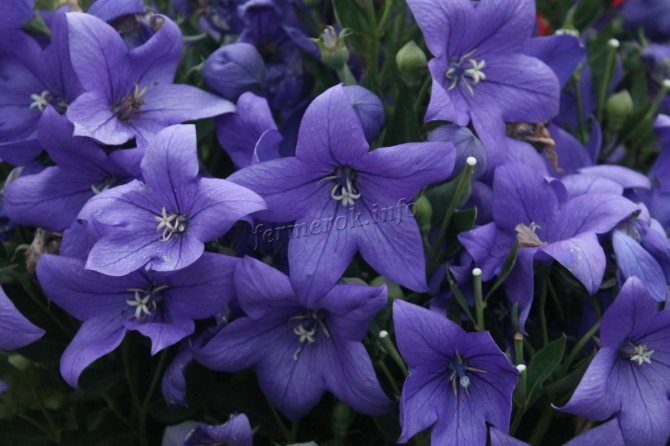

Platycodon is a perennial plant from the Bellflower family. Its homeland is some regions of China, Korea and Japan, the Far East. It grows in the wild on vast steppes, meadows, forest edges and outskirts, on rocky slopes.
The culture has a bare stem of a bluish color, 40 to 120 cm high. It is straight, smooth, thin, simple type. The root is similar in shape to a white radish, fleshy and dense in section. The leaves grow along the stem. The color is light green, the edges are with blunt teeth, and the apex is slightly pointed and curved.
Interesting!
Platycodon is also called "large-flowered bell" and "Japanese bell".
The inflorescence is branched. It can be up to 25 cm long. On thin peduncles there are large single bells - flowers. The color of real platycodon (in the natural environment) is blue, but the cultivated varieties can have a color from white to blue, and veins of a more pronounced tone are possible on the surface of the petals. In diameter, one such flower can be up to 10 cm. Flowering usually falls in July or August, although it can differ significantly in different varieties.
The fruit is an egg-shaped capsule with 5 teeth on one side that open as it ripens. From them elliptical, black, smooth seeds spill out. There are several dozen of them in each box.
Description
Perennial grows in Korea on rocky soils, Eastern Siberia in glades, in the Land of the Rising Sun and China. Flowers in the form of large, large bells, hence the name. It gained fame from the middle of the 19th century, but gained popularity at the beginning of the 20th century.
It can reach a height of up to 1.2 m, the rhizome is a large bulb with root processes. Leaves are light green, elongated towards the ends, may have denticles along the edges. Bell flowers are large, up to 8 cm, can be single or up to 5 pieces per stem, color from blue to white.On the bell flower itself, streaks (thin lines) of a darker color are clearly visible.
Flowering begins in July and lasts 2 months. During this time, an egg-shaped box is formed, where the seeds are located.
Types and varieties of Platicodon
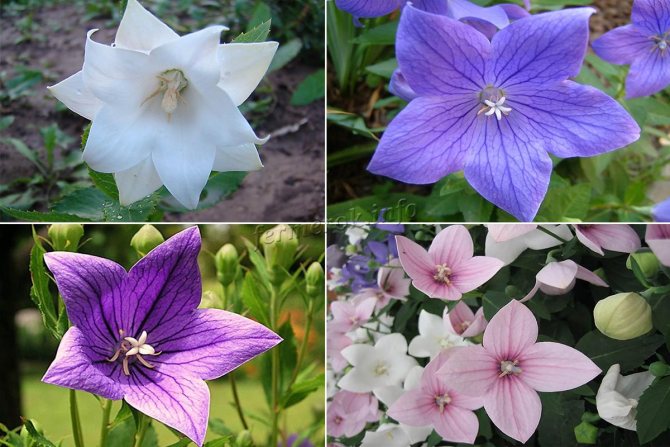

The Platycodon flower cannot fail to attract attention. Large petals have an almost perfect shape and, opening, are a real miracle of nature. Not surprisingly, breeders are interested in him. Despite the fact that there is only one type of plant - large-flowered bellflower, many hybrids have been created over the years of study, grown in apartments and in flower beds.
- «Aster "- a variety combining double and white hybrids. It is a compact plant growing up to 25 cm. It blooms in summer for 2 months. The flowers are large, double, 8 cm in diameter, semi-double, star-shaped - with 10 petals of white, pink and blue.
- «Pink "Variety (" pink ") has very beautiful, delicate pink flowers with bright pink veins on the petals. It is suitable for indoor growing or cultivation in small flower beds.
- «White »Platycodon is dwarf, as the stem grows no more than 20 cm. It is a very light-loving variety that blooms from July to August or August to October. Needs fertile and drained soil.
- «Blues »Grows up to 15 cm in height, it is recommended for growing on rocky hills, rock gardens. The flowers are large, usually white, but the veins are blue.
- «Sentimental blue "- a dwarf hybrid that grows no more than 30 cm. The buds are large, beautiful, purple in tone.
- «Album "- a hybrid, characterized by high growth - 60-80 cm. The buds are large, with a diameter of 8 cm. The color is blue, but the veins stand out in a more saturated tone. Suitable for composing compositions in flower beds.
Characteristics of platycodon and its varieties
The flower has the Latin name Platycodon grandiflorum and belongs to the Bellflower family. In the wild, it can be found in forest glades and mountain slopes of Eastern Siberia, the Far East, Japan, Korea and China. At the end of the eighteenth century, Platycodon was introduced to Europe and after a few decades it received universal recognition from many flora lovers.
Appearance and features
Grandiflora belongs to herbaceous perennials. Depending on the type of plant, the height of its stem ranges from 13 to 85 cm. On the stem are leaves of bright green color, which have an elongated shape with jagged edges and a slight sharpness at the end.
Platycodon bloom begins in early summer and lasts until the end of August, after which oval fruits containing seeds are formed on it. The buds can have both single and group arrangement and reach 8.5 cm in diameter. They are painted in white, pink, blue, red-violet colors. The petals of inflorescences of cold shades are usually penetrated by a net of delicate veins. Under natural conditions, the shade of Platicodon flowers is only blue.
The buds consist of five wide petals, which gradually taper towards the edges. There are also terry inflorescences with additional petals around the corolla. Thanks to this design, the flowering of grandiflora looks especially beautiful. It should be borne in mind that the buds and stems of this plant contain white sap, which is considered poisonous.
Common varieties
Platycodon is a flower that has many subspecies, which are divided into tall (Fiji) and dwarf (Astra). The most famous and popular are the following varieties of perennial plants:
- Album. It has a straight green stem 65−75 cm long. It has rather large bell flowers. Platycodon Album is very popular due to the unusual color of its buds - white with blue veins. It blooms throughout the summer and is widely used to create landscape compositions.
- Mariesii blue.It is a small bush up to 37 cm high with spectacular inflorescences of a bright blue hue. Private house owners prefer this plant for flower arrangements.
- Shell Pink. Shoots usually reach a length of 75 cm. The inflorescences of this platycodon are pink and large, with a diameter of 7.5 cm. Such plantings are great for decorating paths and look great in combination with flowers of different shades.
- Fairy Snow. Differs in large inflorescences, the color of which can be white or lavender. The buds look very sophisticated due to the additional decoration - thin dark blue branches on the petals. The bush of the subspecies is tall and can reach 85 cm in height.
- Snowflakes. The height of this planting is 50 cm. Its flowers are semi-double, white, which look beautiful against the background of green grass and in group plantings with representatives of another variety.
- Apoyama. A low-growing bush with large leaves 20 cm high. The buds have an interesting star-like shape and are purple in color. Due to its compactness, such a grandiflora can be planted in a pot and grown at home.
- White. A small flower, reaching a height of only 18 cm. The petals of the terry inflorescences are white and look very elegant and elegant. This plant is distinguished by its late flowering - its buds usually bloom in late August or early October.
Birdhouse flower, planting and care
Flowering plantations of all varieties have a visual appeal, so they are often found along the alleys of city parks, decorate the lawns of summer cottages and are used as indoor plants.
Reproduction of platycodon
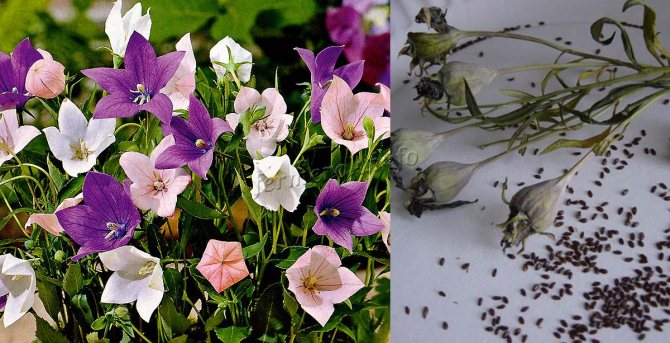

Reproduction is carried out by the seed method, but sometimes the division method is also used, although it is believed that the latter option is unreliable and gives the desired result only in rare cases.
Seed propagation involves growing seedlings. It is better to buy seeds in good stores so that the chances of germination are higher. There is no need to soak them, if they are of high quality, they will germinate quickly. Sow seeds in open ground or in separate boxes. It is done in open ground in the fall, and in boxes in April.
For the emergence of seedlings, you need to maintain the temperature within + 15 ... + 17 degrees Celsius and then after half a month or a little more you can observe the first shoots. Watering is done moderately - the earth should be only slightly moistened. And when the sprouts are 1 month old, you can transplant them to a permanent place - in a pot or on a flower bed.
If there are shoots and buds on the root, you can separate them with a sharp knife, sprinkle the cuts with ash and immediately plant them in the ground. This method of reproduction sometimes gives good results, but in general the platycodon does not like it when its bushes are divided - the survival rate of shoots with buds is very low. On the other hand, this method allows you to preserve varietal characteristics.
Reproduction of grandiflora
There are several options for obtaining a new plant. The most effective of these is sowing seeds for seedlings, which are subsequently transplanted into open ground. Gardeners prefer to use this particular method, as it is the simplest, most reliable and proven.
To acquire a magnificent flower garden of bells of different shades, the plant can be propagated by the following methods:
- Seed. Here, the seeds of grandiflora are used, which are planted in a greenhouse to obtain seedlings. The procedure should be carried out in early spring. Before sowing, the grains are soaked for 2 days in water and after they swell, they are planted in boxes with prepared soil. Planting material should be placed at a shallow depth - about 5 mm, or simply poured onto the soil surface. Then cover the containers with foil, put in a warm place and regularly moisten the soil. Seedlings usually appear in 2 weeks.When leaves are formed on them, the sprouts must be transplanted into pots, and in June - on the street.
- Cuttings. In this case, you need to cut off a small process from the plant and place it in a solution that stimulates root growth for 24 hours. Then you should plant the shoot in the moist soil of the greenhouse. After about 30 days, a root system is formed, after which it can be planted in open ground.
- Division of the bush. This method is suitable if Platycodon grows in rather loose soil with a lot of sand. You need to dig out a bush and divide it into 3 parts with a sharp knife. Then all sections must be covered with ash and the plants must be planted in prepared places on the site. This method is unreliable, as the fragile roots of the flower can be severely damaged during the procedure.
Home lily care
Vegetative propagation is poorly suited for grandiflora and requires some experience. However, this method of obtaining a flower can guarantee the preservation of the hereditary qualities of the original variety.
Planting and transplanting Platicodon
The principle of planting and transplanting crops is approximately the same. The main difference is that usually young shoots are planted, and grown ones are transplanted. But there is no fundamental difference - both procedures require attention, accuracy and compliance with all norms.
The time and method of planting Platycodon depends on many factors: climate, variety, location, and so on. In the southern regions, it is better to do this in the fall, and Japanese bells are simply sowing, mulching and waiting for shoots in the spring (they do not freeze). In the north, the seedling method is always used, and the first planting of young shoots in a permanent place comes in the spring.
Important!
Platicodon flower can be planted in open ground only when the soil temperature reaches +5 degrees.
When sowing seeds in open ground, ditches are made in the fall or they are simply scattered randomly over a delineated area, and then sprinkled with earth. For the winter, the crops are mulched, and the seeds quietly winter in the ground, and shoots appear around May.
It is interesting: Planting and caring for ageratum in the open field, reproduction and varieties
When planting with sprouts (seedlings), you need to make separate pits, not very deep, water them, wait until the water is absorbed. Then a sprout is taken, placed in a hole and the roots are sprinkled with earth (as when planting tomato seedlings or other garden crops). After that, you need to leave the plant for 1-2 weeks to take root and get stronger, and then you can begin to carry out standard care procedures at home.
Caring for a wide bell
Watering platycodon is a very controversial point of plant care. Stagnation of water and excessive watering for shirokololchik is destructive, but drought is far from it. But since the drying out of the substrate for a long time has a detrimental effect on the duration of flowering, it is better to provide additional watering from the budding period to the end of flowering. They should be carried out in moderation, only when there is not enough natural precipitation and all plants are suffering from drought.
Platicodon gratefully responds to feeding. For this plant, the fertilization regime is determined by the soil in which the platycodons grow. If the soil is super nutritious, in the first year after cultivation, you can carry out only one mulching of the soil with organic fertilizers and add complete mineral mixtures at the budding stage. From the second year of cultivation or on ordinary garden soil for Platicodon, two types of dressings are applied:
- Organic mulching (peat, compost, humus), which can be carried out in early spring or early autumn;
- Top dressing with full mineral fertilizers in May, June and July with an interval of 1 month between dressings.
It is this strategy that makes it possible to achieve the longest and most abundant flowering of the shirokokolokolchik.
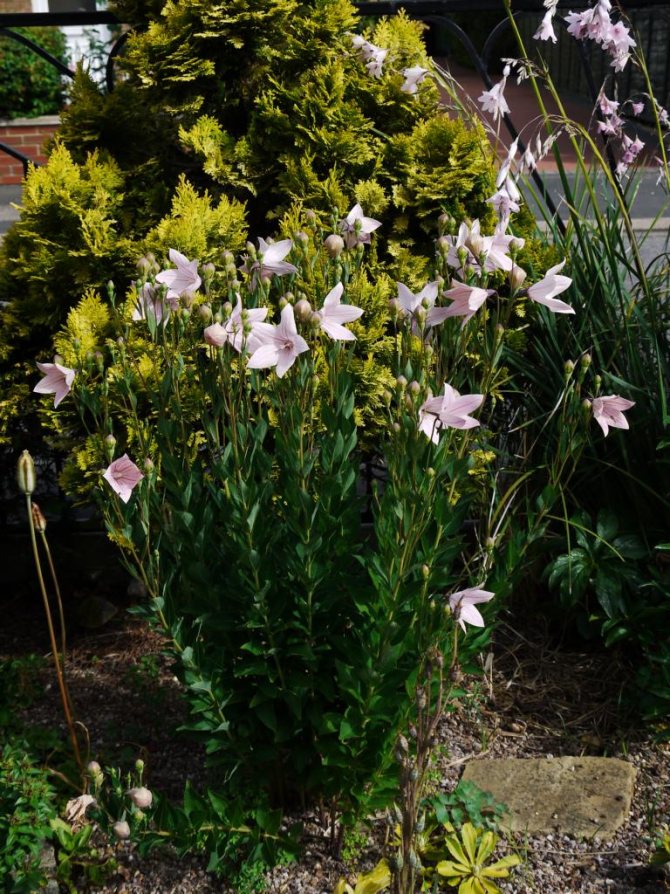

Platycodon, or Shirokokolokolchik large-flowered, variety "Mother of Pearl".
Otherwise, caring for platycodons is not at all difficult:
- remove wilting flowers to prevent seed formation and stop flowering and to stimulate as many new buds as possible;
- if the bushes are too tall and powerful, and the shirokolochik grows on a windy area and begins to lie down, tie the plant to a support in time;
- in the fall, after the beginning of drying, do not expect the bushes to die off on their own and cut all the stems as low as possible.
Platycodons, despite their extraordinary beauty, are resistant and hardy plants. They perfectly tolerate winters in the middle zone, adapt well even at a very young age (fragile seedlings of small size). But Platycodon is not very fond of snowless winters, therefore, to stabilize the conditions, it is better to mulch them every year with any available plant materials (for example, dry leaves). Mulching is desirable to carry out immediately after pruning the bushes.
Features of planting and transplanting
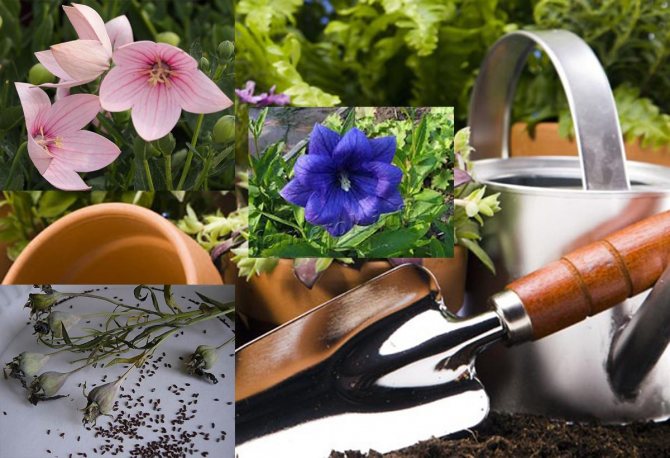

How to plant a platycodon flower was mentioned above. However, there are some nuances of planting or transplanting a plant that need to be discussed separately.
- The place for planting Platicodon should be sunny. When growing in a room, place it on the west or east window.
- The best neighbors in a flowerbed for a Japanese bell will be peonies, asters and phlox.
- The land should be loose, drained - this is what you should focus on when buying. If the mixture is made at home, then it must be composed of equal parts of peat, compost, humus and deciduous soil.
Important!
If you plant a Japanese bell in the shade or partial shade, it will stretch, bend and give only a meager color.
- It is important to always control the acidity of the earth. If it is increased, dolomite flour is introduced, if it is lowered, then it is necessary to slightly oxidize it with iron sulfate.
- Before planting a platycodon flower, it is worth adding organic fertilizers to the ground. They decompose more slowly, and therefore can nourish the sprouts for several months, while mineral supplements are enough for only a week to a month.
- An adult culture is transplanted approximately once every 5-6 years if it grows in a flower bed (in the open field). An indoor flower (adult) is recommended to be transplanted every 2-3 years, and a young one - annually.
When does platycodon bloom?
There are forms with dark purple and white flowers. The unusually swollen flower buds are like lanterns. It blooms for two months, starting in mid-July. The fruit is an ovoid capsule with flat, glossy oval seeds.
Platycodons are not aggressive and grow for a long time in one place, without degenerating, they go well with most garden flowers: phlox, daylilies, peonies, Siberian irises, asters, sedum plants, cereals, geraniums, wormwood.
Dwarf varieties are an excellent decoration for rocky gardens, compositions with miniature varieties of conifers and deciduous species. Shirokolokolchik will please with its presence on the windowsill.
How to take care of Platicodone at home?
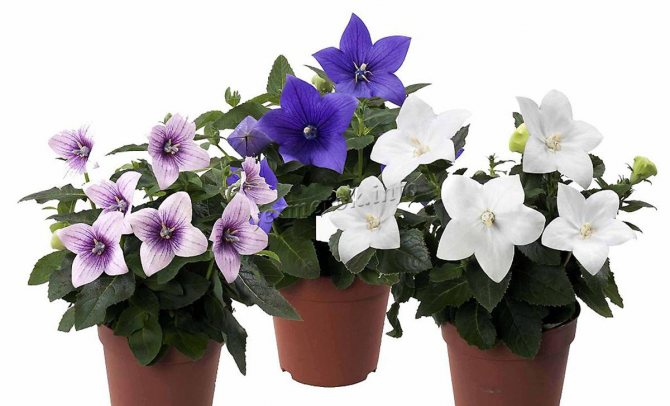

Growing a platycodon flower in the open field or on a windowsill requires some care, otherwise colorful flowering can not be expected.
- After transplanting or planting, it is recommended to pinch the top of the culture and tie it to the support. This is done so that the flower does not immediately start to bloom, but takes root in a new place, takes root, lets out a green mass, and then gives flowers.
- Watering is always moderate - without fanaticism, because swampy soil will certainly lead to the development of root rot. So, in the rainy season, you can not water the flower at all in the open field, and in the hot summer, do watering every 3-4 days and make sure that the water does not stand. For a houseplant, the norms are also controlled, but watering is carried out regularly!
Important!
When the crop begins to form fruits (this is usually autumn), watering is reduced.
- Home care for Platicodon requires timely fertilization. If we are talking about garden culture, then this is done every 14 days during flowering and the most active growth (spring, summer). For indoor platycodon, feeding is carried out once every 15 days (during the period of active growth). Complex fertilizers are needed for flowering plants.
- Any weeds are pulled up, and the earth is weeded from time to time.
- If a variety with a high stem is grown, it will have to be tied to a support, since the stems are thin. So after they stretch out, you need to install a support and tie them up, otherwise, under the weight of the buds, they will simply fall to the ground.
- All dried inflorescences are cut or torn off to increase and extend the flowering period.
Features of growing a plant
Grandiflora is quite hardy, does not require complex care and can grow in one place for a long time. But for good health and normal development, she needs to provide a comfortable living environment in order to enjoy the delightful flowering of bright bells every year.
Planting a garden flower
Platycodon is very fond of light, therefore, it should be planted in places with good lighting or in slightly shaded areas. Since the root system of the plant has a rather delicate structure, do not forget that frequent transplants can quickly destroy it. Therefore, you must immediately choose a permanent place where the flower will grow quietly for 8-12 years.
It is necessary to plant seedlings in open ground at the end of spring, when warm weather sets in and the soil warms up enough. The plant prefers loose and vitamin-rich soil. The flower does not tolerate waterlogging, therefore, land with the presence of groundwater is not suitable for him. Loamy soil, to which ash and complex fertilizers are added, will contribute to good growth and the rapid appearance of buds.
In order not to damage the roots, you need to transplant the seedlings very carefully. Before removing small plants from the pot, water the soil in it, and then carefully pull out the planting material. It is necessary to plant grandiflora in a new place with a soil clod around the roots, so it cannot be removed.
Fat tree plant (money tree)
Planting a platycodon flower and caring for a young seedling should be carried out in this way:
- The land on the site where the flowers will grow must be dug up and added to it 100 g of wood ash and 20 g of complex fertilizers (per 1 square meter).
- Then you need to dig small holes, given that the distance between them should be about 20 cm.
- After that, the seedlings must be placed in the holes, covered with soil and tamped a little.
- Now the planted plant must be well watered. It is recommended to mulch the soil around the base of the stems with a layer of peat or last year's foliage. Thanks to this, the soil will not dry out in hot weather and weeds will not appear around young flowers.
- In the first 14 days after planting, Platicodone must be watered every day and make sure that no fluid stagnation forms. Every 3-4 days, the soil must be loosened for more free oxygen penetration to the roots. Then you should gradually reduce the frequency of hydration and switch to care appropriate for adult plants.
It should be borne in mind that if different varieties of grandiflora grow on the site, then they can be re-pollinated. Therefore, in order to maintain the purity of the subspecies, it is recommended to grow only one variety of flowering plant in the garden.
Basic care
Platycodon is very resilient, hardy and does not require much attention. You need to water an adult flower 1 time in 3 days, as well as periodically loosen and weed the earth. In especially hot and dry summers, the soil can be moistened more often, not allowing it to dry out.
Planting, growing and caring for herbal cloves
If the plant is planted in high-quality and nutritious soil, then it needs to be fed only in the second year after planting. It is recommended to apply mineral fertilizers every month during the entire summer period. The beneficial substances contained in the top dressing will stimulate the flowering of grandiflora. With the onset of spring or early autumn, the soil near the flowers must be mulched using organic mixtures.
These plants stretch very quickly, so they can get too long and look messy. To prevent this from happening, during the year they should be pinched or sprayed with compounds that slow down the growth of stems. If the bushes still become quite tall, it is recommended to tie them to a special support so that the flower garden looks more aesthetically pleasing.
With the onset of cold weather, Platicodon needs to be prepared for the coming winter. To do this, the stems must be cut off and the entire area covered with dry grass or humus. At the beginning of March, the land needs to be freed from shelter, and with the onset of warm days, new shoots will appear in this place, which will quickly turn into beautiful bells.
Diseases and other growing problems
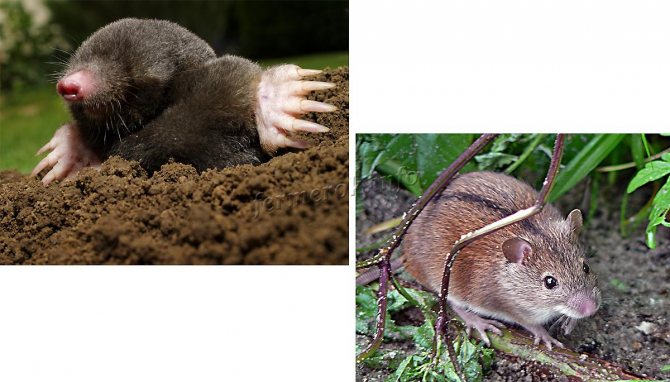

Healthy, large plants can only be grown from quality planting material. You can purchase it from a certified flower shop. Buying planting material from the market or from strangers may cause the plant to get sick often or the seeds themselves will already be infected. What problems do flower growers most often face?
- Mice and moles often eat the plant's turnip root. To help the roots avoid such a fate, crops with poisonous roots are planted nearby. Rodents will instinctively walk away from such places.
Important!
Harmful insects are not interested in flowers, roots, leaves and stems of Platycodon, so no processing is required from them.
- Stagnant water always leads to root rot, so the amount of water during irrigation must be strictly regulated. If this happens, you need to dig out the root, cut off all damaged areas, then disinfect the sections and transplant the plant to a new place.
- If nothing is done when the root system decays, gray rot will develop and the plant will die as a result, since even treatment with fungicides will not help from this disease. The only option is to discard the crop so that the disease does not spread to neighboring flowers.
Platicodon is in great demand among growers for its beautiful flowers, unpretentiousness, and for the versatility of cultivation. Dwarf species, which do not have a very large stem, grow without problems on the windowsill, and not only in the open field, and large ones stand out in flower beds, pleasing the eye with regular and lush flowering.
Pests and diseases
Platicodone is immune to disease. But under unfavorable growing conditions or poor care, the plant can be affected by such ailments:
- Gray rot. It is manifested by the gradual decay of the root system. Usually occurs due to waterlogging of the soil. You can get rid of the disease with the help of regular loosening of the soil. If this does not help, you need to dig out all the affected flowers and destroy them, and spray the rest with fungicidal agents. After 7-10 days, the treatment should be repeated.
- Insufficient growth. If grandiflora does not develop well, the land in which it grows may not be suitable for it. In this case, it is recommended to increase the ventilation of the soil, add sand to it and apply mineral fertilizers.
Most often, the plant is attacked by rodents - moles or mice. They can eat up the roots of flowers and spoil young foliage. You can fight them with the help of poisoned baits or by smoking animals from their holes, blowing smoke there. It is worth considering that rodents appear in moist earth rich in insects.It is almost impossible to find them in dry soil.
If you follow all the simple rules for caring for Platycodon, you can quickly grow a gorgeous plant, which with its multi-colored splendor will cheer up every day and will become a wonderful decor for the garden for many years.
Bush formation
Most varieties of Platycodon are quite tall. If your site does not need its long stems, then you can form a bush of the required shape. To do this, you need to regularly pinch the upper long stem.
But it is important to choose the moment when this manipulation can be done. If the period is missed, then you will have to tie up the stem so that it does not fall on its side.
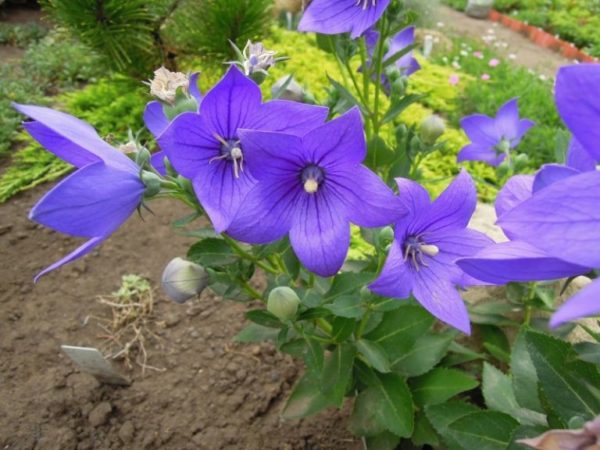

Inhibitors can be used to make the shrub lower. To preserve the attractive appearance of the plant, faded flowers must be cut off in time.
Possible problems
Platycodones are disease resistant. The greatest danger to them is excessive watering, due to which rot is formed. When areas of damage are detected, simple measures are often sufficient: reduction of watering, loosening of the soil. Damaged plant parts are removed during transplantation. A transplant can be an emergency measure. If the rot continues to spread despite the measures taken, then it is necessary to use fungicides for disinfection.
Flowers are not in vain used in oriental cooking. Their taste attracts various rodents. To drive out mice and moles from the site, you can use various rattles, fill the holes with water. If a platycodone needs a transplant, then it is best done in winter, when the plant is dormant.
Platicodon is easily cross-pollinated. Therefore, if you yourself are harvesting seeds for further planting, you must be careful when placing other plants nearby in order to avoid losing the characteristics of the variety in the future.
Where can you use the bell
In landscaping, plants can be used for a variety of purposes. They allow you to make bright spot accents on meadows and lawns, in flower beds. Bells are often used as partners for roses and other plants. Flowers look great in compositions that involve continuous flowering. Plants can not only be used in combination with other types of flowers, but also be used alone. Platycodone is also used in bouquets.
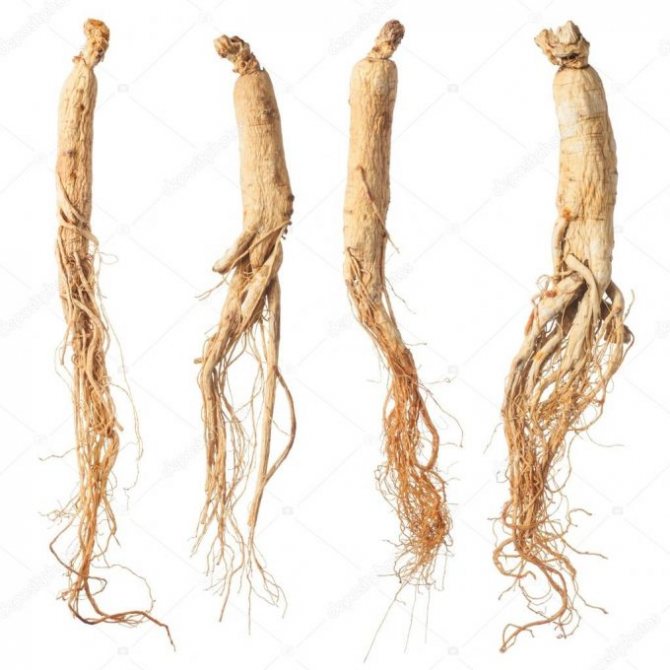

Toraji-namul
The prepared root, from which the bitterness has been removed, is cut into strips. A little finely chopped green onions, garlic and half a spoonful of ginger, sesame oil are added to it. The mixture is fried in a pan, add 100 ml of water and stew until the water has completely evaporated. After that, add a little more sesame oil, salt, and the salad is ready.
Now read:
- Planting to decorate the site with three types of conifers
- Choosing cucumbers for open ground according to your preferences
- Exquisite junkus (sitnik) spiral in the interior
- Flowering of a capricious oncidium, after a neat transplant
About
Agronomist of the state agricultural enterprise "Garovskoye" of the Khabarovsk region of the Khabarovsk region.
Varieties and hybrids
A large number of varieties and hybrids, differing in size, color and other features, have been bred on the basis of the original species of Platicodon. Since the original is one species, the principles of growing and caring for all varieties and artificially bred hybrids are almost the same.
Among the most famous varieties are the following:
- Album. A tall variety, reaching a size of up to 80 cm, is often used for the second or third tier of compositions. Blooms white. Early flowering, because flowering begins in June.
- Shell Pink. It differs from the previous variety in the color of the petals, they are pale pink. When choosing this variety, experts recommend paying attention to the increased moisture requirement of the variety.
- Marisil Blue. Compact form, the shoots of which do not exceed 35 cm. Forms a dense ball, covered with lavender inflorescences.
- «Fairy Snow ". Tall plants with very large single inflorescences of light lilac or white, along which blue veins run.
- Snowflax. Hybrid with semi-double inflorescences of white color. The main shoot does not exceed 50 cm. A large amount of bright light is required for normal maintenance.
- Mather of Pearl. Tall hybrid with very dense branching and large pale pink inflorescences. Rarely grows above 60 cm.
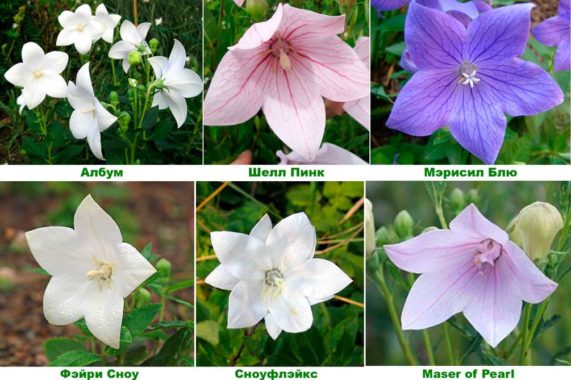

Platicodon - landing
For a flower to please the eye, take root well and grow, it is necessary to plant it correctly, for which it is worth following a number of recommendations.
- It is important to choose the right place for growing, since it belongs to the light-loving, it is better to give preference to well-lit or semi-shady areas.
- When choosing a platycodon for your site, planting and caring for which is simple, keep in mind that its root system is delicate and fragile, so transplants are categorically undesirable for it. Considering this, it is important to immediately choose a permanent place where the plant will delight for 7-10 years.
- Pay attention to the quality of the soil, which should be fertile, loose and well-drained. It is best to choose loams with a neutral reaction for planting Platicodon. During digging, it is recommended to add additional sand, and directly during planting 0.5 tbsp. wood ash and 1 tbsp. a spoonful of complex fertilizers.
- Correct planting of Platicodon should be carried out carefully so as not to damage the roots of the seedlings. It is necessary to make holes, the distance between which should be about 25-30 cm. Their volume should be slightly larger than the pot in which the seedlings were grown. The plant must be well watered and then removed from the container along with a clod of earth, then the chance that it will be accepted will be high.
- Water the bush at the end of the process. Mulching is recommended, as this will prevent the soil from drying out and cracking during the heat. In addition, the amount of weeds will be significantly reduced.
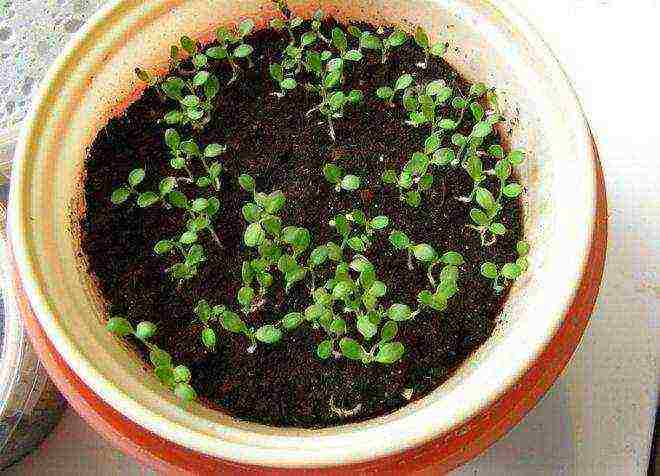

When to plant Platycodon?
You need to choose the time for planting taking into account whether seeds or seedlings are used. In the first case, one should focus on temperature indicators, so the earth should warm up by more than + 5 ° C. If you are interested in how to plant platycodon seedlings, then it is better to plant at the end of May. Due to the observance of these conditions, the chance that it will be accepted and will develop well increases significantly.
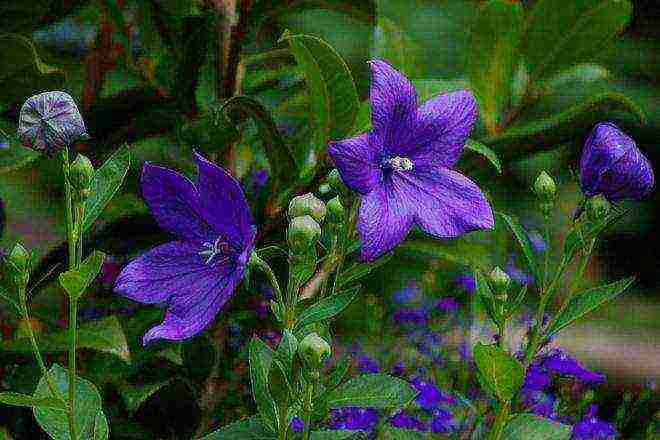

Platicodon - growing from seeds
To obtain seedlings, planting seeds must be carried out in early or mid-March. There are a number of recommendations on how to sow Platicodon, planting and caring for which has its own characteristics:
- Since the seeds are light sensitive, they should be sown closer to the ground, which should be loose and light. You can simply press the seeds with your finger without sprinkling anything on top of them.
- After that, cover the container with foil or glass, which will create the effect of a greenhouse. It is recommended to place them in a place where there is a lot of light, but the seedlings must be protected from direct rays.
- Subsequent care for Platicodon ordinary involves regular moderate watering and maintaining an optimal temperature regime (20-23 ° C).
- If everything is done according to the rules and the planting material was good, then the seedlings should appear after 2.5-3 weeks. After that, it is recommended to lower the temperature to 15-16 ° C and periodically ventilate the greenhouse by removing the film or glass. The condition for moderate watering remains.
- It is worth pointing out that platycodon, planting and care of which should be carried out according to the recommendations of gardeners, does not need stratification, that is, cold treatment, but if the procedure is carried out, then germination can be accelerated.
- When buying seeds in the fall, you can plant in the garden in the winter. They need to be planted shallow, covered with a layer of compost or sifted earth on top (2-3 cm thick). Seedlings appear in late May or early June. Platycodon will develop slowly, and flowering can be observed only after 1-2 years.
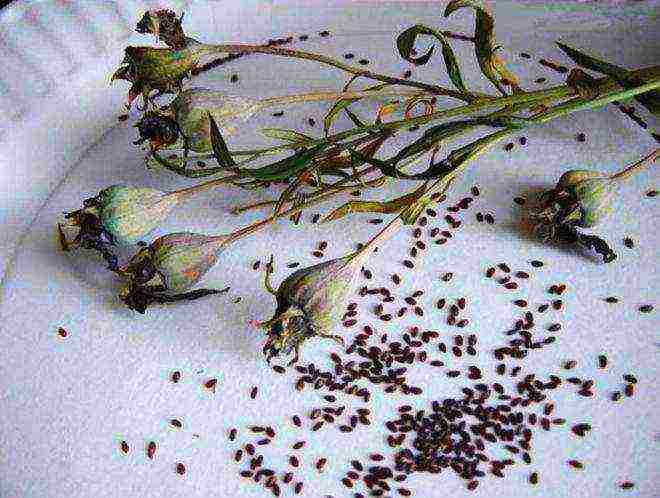

Platicodon - propagation by cuttings
You can increase the number of such plants and vegetatively. For this, it is worth considering a number of recommendations:
- In spring it is necessary to choose a stem with a heel and separate the stalk. An incision is made at the root collar. It is important that there are 2-3 internodes on the stem. The cuts are processed with garden varnish and sent to the water until the roots appear.
- Using vegetative propagation of Platycodon, you can also divide the bush. First, it should be carefully dug up and examined. If the rhizome has processes with buds, then they can be separated using a sharp knife. All that remains is to plant the bushes in the holes, observing the rules.
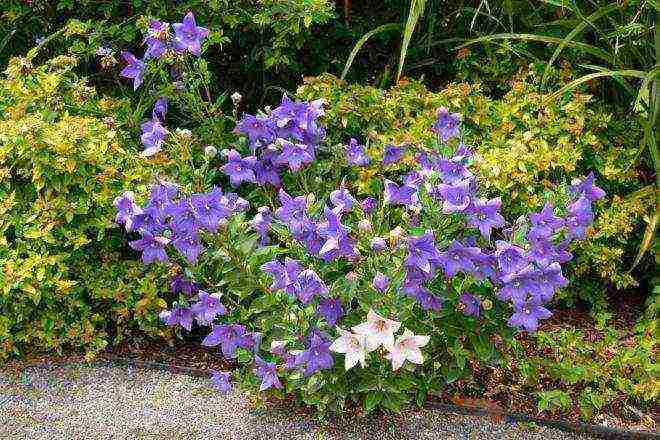

Preliminary preparation of the soil for planting
In about 2 weeks, or even more, it is necessary to prepare the site for planting Platicodon seedlings. For this, the earth is carefully dug to the depth of the bayonet of the shovel. Simultaneously with the digging, wood ash and mineral fertilizers are introduced into the soil.
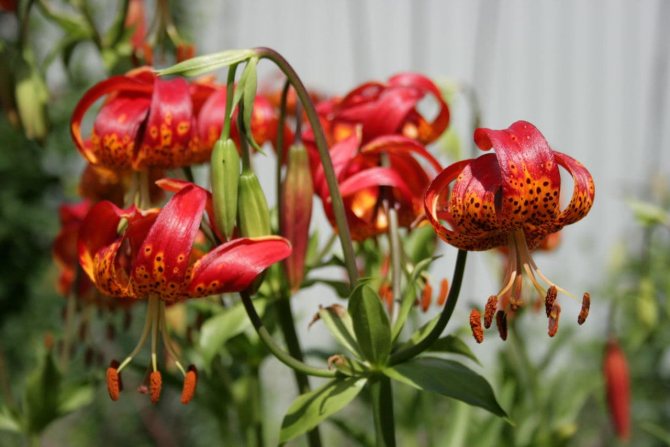

You may be interested in:
Lilies in the fall: care and preparation for winter shelter, pruning Lilies are perennial, demanding flowers. For bulbous plants to grow well and always bloom, it is necessary ... Read more ...
Landing
For a plant to bloom for a long time, you will need to provide it with a sufficient amount of light. Platicodon does not like darkened places. With a little shading, it stretches, but well-prepared seedlings can take root in the secluded places of the garden. Platycodon can be sown in spring and autumn, but spring planting is more often used.
The soil
When planting, choose a soil with good drainage properties. The bushes will grow well and bloom only in the absence of stagnant water. If water accumulates at the landing site, then drainage must be used. The delicate root system of Platycodon does not tolerate repeated transplants, so you need to make sure that the plant can grow calmly for 5-10 years.
Light loams, rich in nutrients, are best suited for Platycodon. When digging, you can add some ash and fertilizers to the ground.
Seed preparation
Platycodon is best grown from seeds that can be placed directly in the soil or grown seedlings first. Before planting, the seeds are soaked for a couple of days in a gauze bag. The germination time depends on the characteristics of planting and care and ranges from 10 to 21 days.
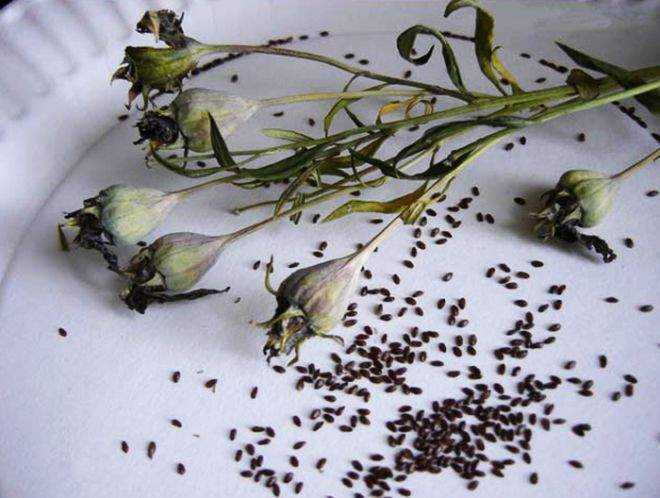

Seedling
You need to sow seeds in a container with a prepared earthen mixture at the end of February. For its preparation, sand, humus and peat are mixed in equal proportions. The seeds are planted to a depth of half a centimeter, after which the soil is moistened. Before the sprouts appear, the container is covered with a film and kept in a warm room for about a week with daily watering.
When green seedlings appear, the boxes are rearranged to the light, and the film is removed. The appearance of several leaves indicates that the seedlings are ready for picking, and before the final transplantation into the ground, the plants will be in small pots with a diameter of 10 cm.
Popular: Flowering of a capricious oncidium, after a neat transplant
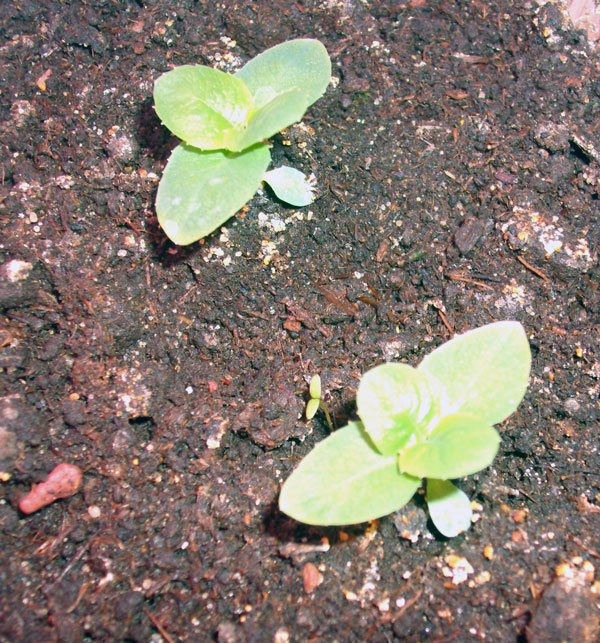

Landing
When transplanting, it is more convenient to work with damp soil, so the soil should be moistened first. The distance between the holes should be about 30 cm, and their size should allow the entire root system to be transplanted from the seed pot along with the earth ball. You need to act as carefully as possible, and this will reduce the stress of the plant from transplanting. Do not shake off the soil or spread the roots, as this will damage the root system.
At the first time after transplanting, the plants need to be shaded a little.For quick adaptation, it is better to transplant on cloudy days, as this will help to avoid too strong sun rays. At first, watering should be sparse, but frequent. Do not let water get on the chimes themselves.
Reproduction
There are three ways of reproduction of Platicodon. But the most effective is seed.
Seeds
Platycodon is best grown by seed. Other methods are less effective. The seeds can be purchased at the store or collected by yourself. Seed germination is very high. Planting material is collected from completely faded inflorescences. The seeds are harvested by autumn. The inflorescences should completely bloom, and the box with the planting material should dry out and begin to crack.
Cuttings
Another way is grafting. But most gardeners are doubtful about this method. Very often, cuttings do not take root. Cuttings are cut from the stem processes, at least 10 cm long. They should have from two internodes.
In early spring, cuttings are buried in special soil for flower crops and covered with a cut bottle to create a greenhouse effect. When they take root, they are planted in the ground.
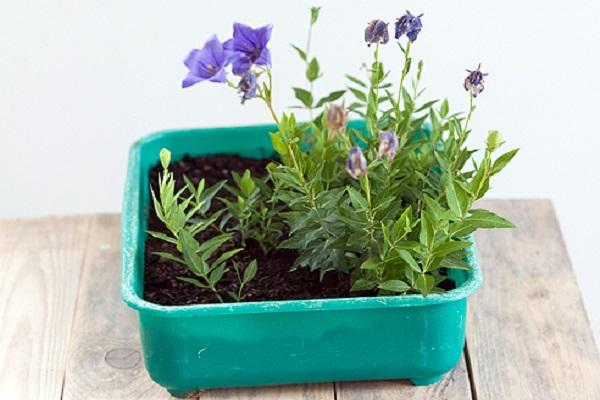

Dividing the bush
Reproduction by dividing a bush is the worst and most unreliable way. Platicodon is one of those cultures that do not like transplanting. Due to the fragile root system, it can hardly tolerate a change of place. Therefore, it is better not to risk and propagate the bush in this way.
Platycodon - oriental flower
Japan is considered the birthplace of the magnificent bell, as well as the Ussuri region, Manchuria and China. Nevertheless, he perfectly took root in European gardens. In central Russia, gardeners observe the emergence of shoots from the ground in the 2nd half of May. And it blooms in July-August. Just as there is no oriental Platicodon flower, striking the imagination with its variety of shapes and shades of petals. Its color ranges from white to purple. Light petals are pierced with blue veins, and, for example, large-flowered platycodon (dwarf "Hanus Pink") shows a bright pink hue. The most popular varieties are:
- Fuji White and Fairy Snow (white);
- Fuji Blue (blue);
- Fuji Pink (platycodon pink);
- "Alba Plena" and "Captivity" - terry platycodon, white and blue;
- "Bumilus" is purple.
All varieties are divided into ordinary and dwarf. Ordinary stems are very unstable. At dense planting of mixborders, “smoothing” occurs. If the flower is planted far from other plants, the stems will have to be tied up. Dwarf large-flowered varieties are devoid of such a disadvantage. Among them are Alpinus (30 cm), Apoyama (25-30 cm), Pumilus (15 cm), Hanus (15 cm). Beautiful "Hanus Alba" and "Hanus Pink" with white and pink inflorescences, respectively.
Platicodon - growing and care
For abundant flowering for many years, a number of recommendations must be followed.
- In the first weeks, watering must be carried out without fail, and then, it is worth focusing on the weather and the state of the earth. If there has been no rain for a long time, then it is better to irrigate.
- For the cultivation of platycodon, it is important to loosen the soil after watering. Please note that weeds growing nearby can impair growth activity, so they should be removed in time.
- For flowering platycodon, planting and care involves the introduction of complex fertilizers, and it is recommended to do this once a month. If you do not want the platicodone to be high, inhibitors that reduce growth activity can be used.
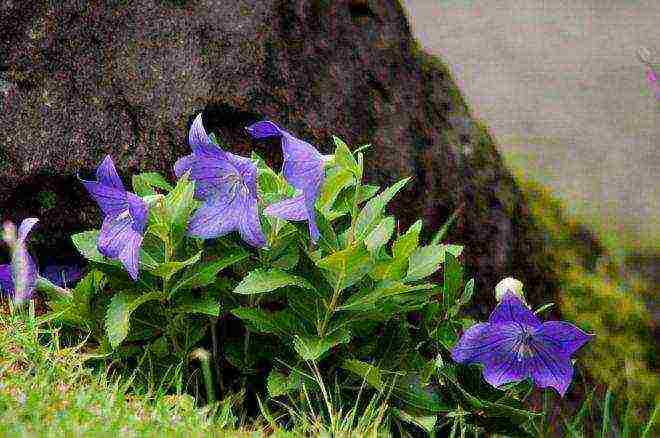

How does Platicodon rise?
Experts say that the length of the germination period depends on many factors. To a greater extent, the variety and compliance with the rules regarding planting and care are important. The minimum period is 10 days, and in some cases the period is extended to 21 days.When cultivating platycodon flowers, you should know that when the seedlings get stronger, it is important to remove the film, and when forming four leaves, it is recommended to feed with nitrogenous fertilizers.
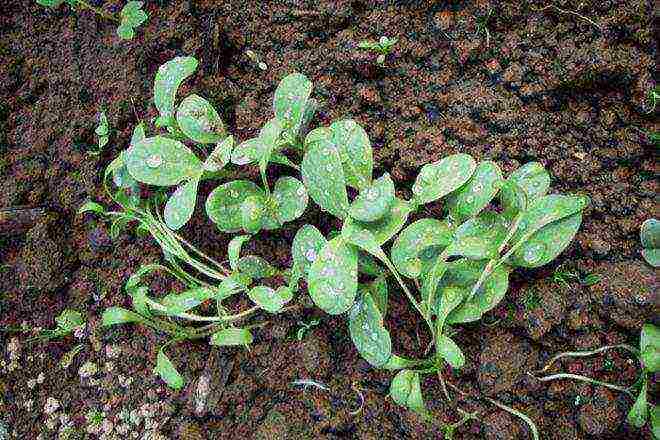

Platycodon - flowering
In most varieties, axillary flowers bloom at the tops of the shoots in mid-June, which are collected in a paniculate inflorescence of 2-5 pcs. The buds have a short and flexible peduncle, so they tilt slightly downward. The corolla consists of five petals fused at the base, so it looks like a bell. There are semi-double varieties in which the petals are placed in several tiers. It is important to note that flowering continues for two months. There are no special rules on how to care for Platycodon during the flowering period.
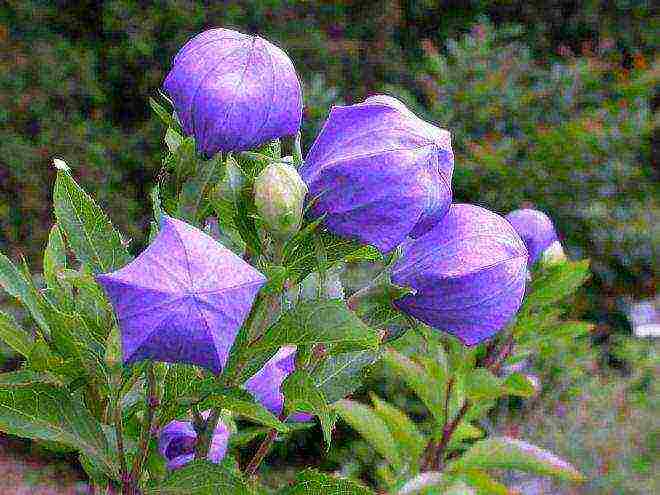

Platycodon picking
In order for the plant to start growing faster, giving shoots, it is necessary to carry out a simple procedure - a pick. On young seedlings, the top is cut off when the third pair of leaves is already formed. Caring for platycodon involves the use of a container with a diameter of about 10 cm for picking. In the same containers, it will grow before it can be transplanted into the ground. It is allowed to lower the pick if the seeds are sown in peat tablets.
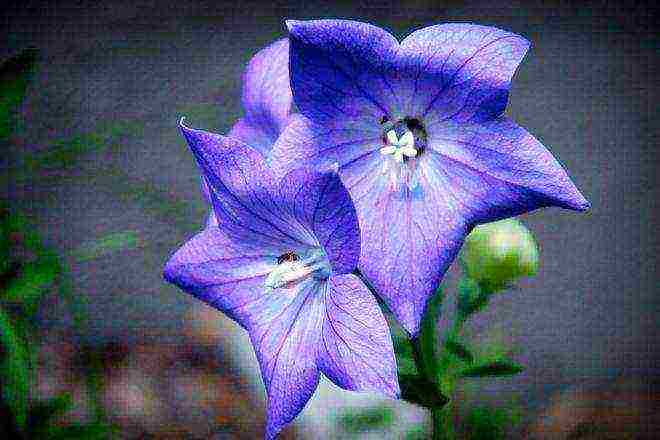

How does Platicodon winters?
When growing flowers in the garden, it is important to properly prepare them for the winter period. To do this, you should take into account a number of recommendations:
- Before the onset of cold weather, cut off the entire ground part so that only the roots remain.
- For cultivation and care in the open field, Platicodon must be covered with fallen leaves, peat or other similar material for the winter. The height of the mulch depends on the terrain and the further north the territory, the thicker the protection should be.
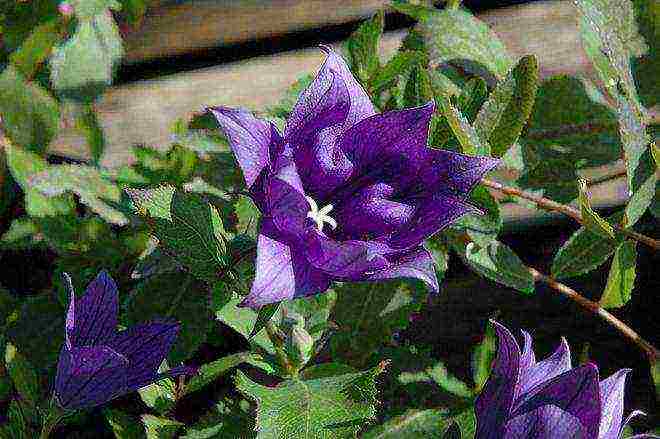

Platicodon after winter
When the cold weather recedes, it is necessary to clean the bush by removing the shelter. Note that it is worth doing this when there is no night frost. Experienced gardeners recommend fertilizing the bushes in the spring using humus or peat. It is important to monitor the acidity of the soil. If Platycodone grows at home, then it is better to transplant into a new pot.
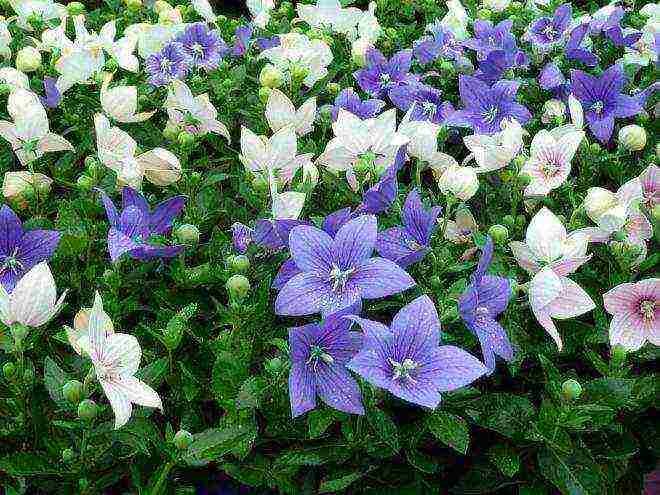

Variety of placticodon varieties: photo
Platicodon - growing in pots
It has already been said that you can grow a plant at home and in this case you need to use the seeds as seedlings for open ground.
- When growing a platycodon flower, as a houseplant, it is recommended to put the pot on a well-lit windowsill, but keep in mind that direct sunlight can provoke a burn.
- The optimum home temperature is 20 ° C.
- When fading buds appear, they should be removed, and the earth around them should be periodically loosened.
- If you want to breed platycodons, planting and caring for which are very simple, it is important to take into account that they do not tolerate waterlogging in a pot, so watering should be moderate, and reduced to a minimum in winter. In addition, in the cold season, the pot must be moved to a cool place, where the temperature is 13-15 ° C.
- Spraying is not necessary, and it is recommended to feed the bush before the bells appear.
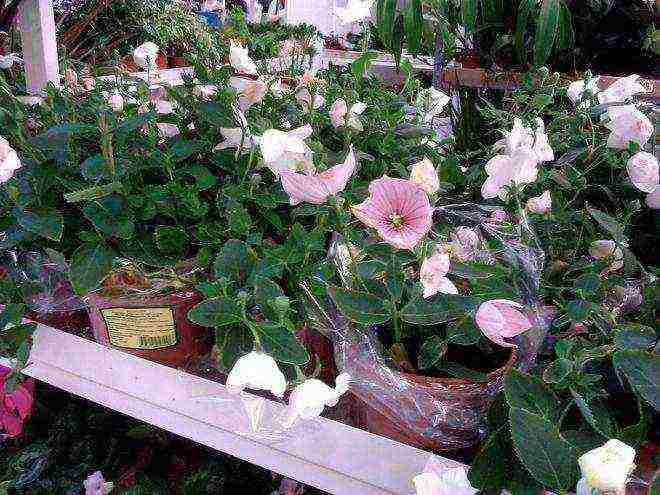

Consider a plant with the Latin name Platycodon grandiflorum. It belongs to the Bellflower family and is considered one of the most beautiful. A bright platycodon turns a photo of a front garden into a motley panel. In Russia, the flower is sometimes called broadly-bell. A very beautiful bell is successfully used in landscape design and in indoor conditions for landscaping interiors. The beautiful flower, native to Japan, is available today for growing in a variety of climates. This is facilitated by long-term selection work and the breeding of hybrid forms. Large-flowered platycodon at home does not require special care, usually planting is carried out by seeds. They germinate rather quickly.By the way, for growing in the garden, it is also advisable to breed this perennial crop by seed seedlings. If proper care of the seedlings is carried out, then flowering occurs already in the first year of the flower's life. Look at the photo of the Platikodon flower, they will clearly show all the sophistication and beauty of the plant:
Care features
In the first days after transplanting, you need to take very high quality care of the plant, water it daily. When the platycodon gets used to the new conditions, watering can be reduced to once every two days. When the soil is moistened, loosen the soil and remove weeds if mulch is missing.
It is important to ensure that water does not stagnate around the bushes after watering, otherwise the plant will rot in a short time. But the flower will not tolerate overdrying either.
Once a month, you need to add a special fertilizing in the form of a complex fertilizer. When 2 years of growth have passed, the bushes will begin to stretch. To make them compact again, you need to purchase a growth blocker. If you do not want to use chemicals, you need to pinch the plants on time.
Elongated shoots can be tied to a support or to each other so that the plant does not lose its decorative features. To increase the flowering period, wilted and old flowers are best pruned.
Diseases and pests
One of the main advantages of the plant is its immunity to various diseases. The root system can be damaged by mice or moles. To get rid of them, you need to use the following methods:
- Place traps with poisoned cereals throughout the site. But this method will get rid of mice only on its own site.
- For the extermination of rodents, it is advisable to blow smoke into the hole. Use a rubber hose that is attached to the exhaust pipe of, for example, a chainsaw. The free end will need to be placed directly into the burrow. With the help of smoke, it will turn out to smoke absolutely all the moles from the territory.
There are situations when gray rot forms on the platycodon. This disease spreads if the soil is too moist. Plants that are planted in poorly drained soil can also suffer from this ailment. To get rid of this trouble, you need to regularly loosen the soil around the planting.
If this method does not work, then the bushes must be treated with a solution called Topsin-m or Fundazol. The latter is applied in two percent form. After 10 days, processing will need to be repeated.
Popular varieties
To effectively decorate a flower bed on your territory, you can choose one of the plant varieties or create a wonderful composition of several varieties. The choice is quite wide, which is why gardeners like the flower so much. Varieties:
- Snowflakes. The plant can reach a height of 50 cm, has white flowers that will look very beautiful among green grass or next to brightly colored plants.
- Apoyama. Outwardly, it is very similar to ordinary bells that are found in the fields. It can grow only up to 20 cm. The leaves are quite large. The flowers are purple or blue, and when they open wide, they are sent in different directions. Ideal for growing in various rock gardens and rockeries.
- Fairy Snow. The flowers have a very delicate white or slightly lilac shade. A row of blue veins can be seen on each petal. The bush stretches up to 80 cm. Flowering begins in June and lasts until August.
- Mariesii Blue. It is a very popular variety. Large blue flowers bloom on the plant. You can make very beautiful landscape compositions. Platycodon blue looks very impressive and is very appreciated by gardeners who prefer to create bright flower beds on their territory.
- Shell Pink. The shrub can reach a height of 80 cm, large pink flowers grow on the shoots. Their diameter is approximately 8 cm.Plants will look beautiful if you place them along the paths. The result is a very effective framing.
- Album. This type of platycodon is distinguished by erect stems. It can grow up to 80 cm. The plant is distinguished by large white flowers up to 8 cm in diameter. If you look closely at the petals, you will notice bluish streaks on some. The flowering period of the plant is from June to August. This variety is very often used by flower growers to decorate their territory and bring notes of freshness to it.
There are also other varieties - Fuja, Fiji. But gardeners and flower growers rarely use them for breeding.
Planting an adult plant on the site
At the end of summer, you can buy an adult Platycodon bush. If you purchased the plant before mid-August, then it is better to plant the purchased plant in a prepared place. It is imperative to provide the flower with sufficient watering.
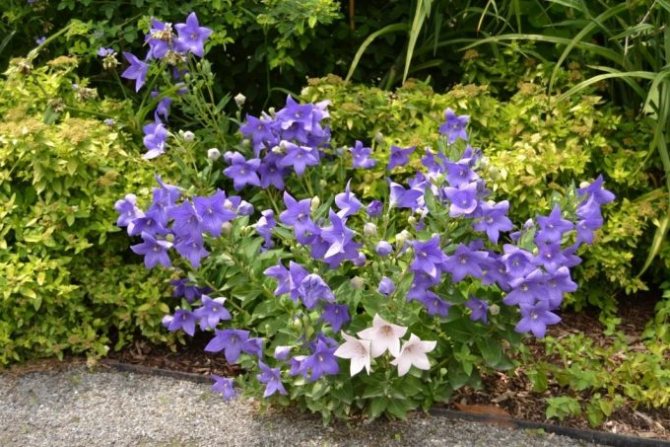

If the bush was purchased in the fall, then planting will have to be postponed until next spring. To keep the flower healthy until this time, you must treat the potted plant as if it had already been planted. To do this, dig the pot into the ground, and in the fall, cut off the stems and securely cover the plant. Make sure that there is no excess moisture; for this, plant in an elevated area.
Care
Caring for a crop is not much different from caring for most flowers.
Watering
Water the bushes as needed. It is not worth pouring the flowers too much, but it is also undesirable to allow the soil to dry out. Water the flower garden after sunset with heated water.
Loosening and weeding
Weeding the flower bed is often unnecessary. It is enough to loosen the soil once every two weeks. Weeds are pulled out as they appear on the site.
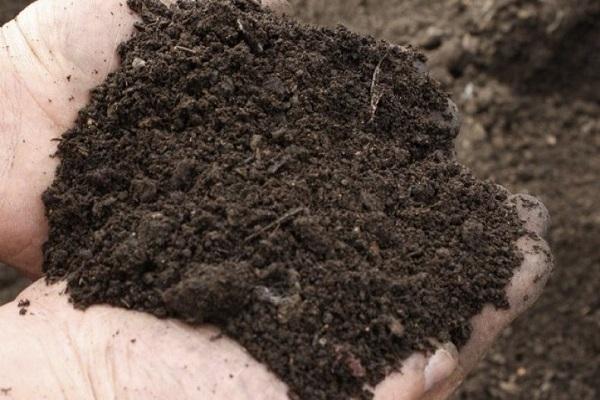

Top dressing
The first feeding can be done after the seedlings begin to sprout. For this, nitrogen-containing fertilizers are used. In the second half of the season, plants can be watered with phosphorus and potassium. Organic fertilizers are also used. The beds are sprinkled with wood ash and then watered. Or watered with infusions of weeds.
Spraying
When grown outdoors, it is not necessary to spray the bushes. During watering from a watering can and rains, this happens naturally.
Preparing for winter after flowering
Platicodon tolerates wintering well. The plant belongs to frost-resistant, therefore, it even experiences a strong cold snap. But it is best to cover the flowerbed with spruce branches for the winter. The bushes are cut before the onset of winter.
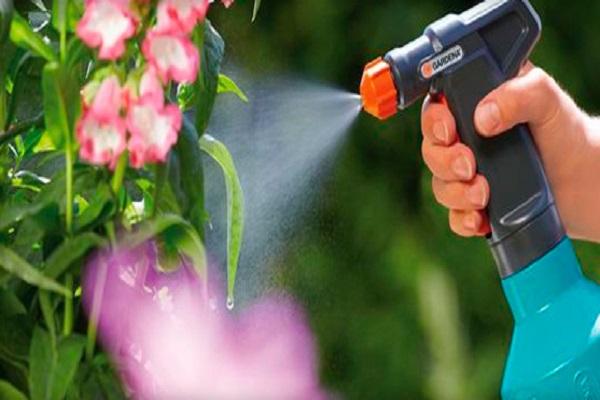

Platycodon in landscape design
Platycodon forms beautiful spreading bushes. They are good in flower beds, in the middle of a lawn, as well as near paths, fences or buildings. The plant grows in breadth slowly and behaves non-aggressively towards neighbors. Large flowering bushes go well with peonies, phlox, irises. Depending on the height of the variety, platycodon is placed in the foreground or in the center of the composition.
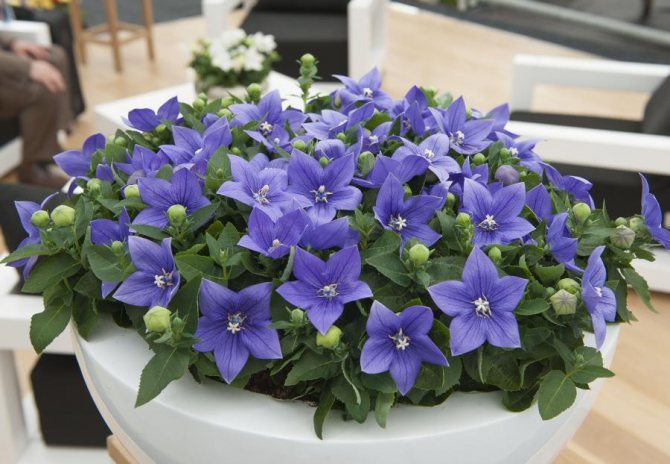

Platycodon will be an excellent decoration for rockeries or alpine slides. They can shade coniferous shrubs. Flowers can be planted in flowerpots and placed on the balcony or veranda. For normal development, Platicodon needs an influx of fresh air, so it will be difficult to grow it indoors.
Platycodon inflorescences can be used to make bouquet arrangements. Flowers will stay in a vase for 7-10 days.
Growing rules
To have Platycodon at home, you can purchase it at a flower shop or grow it yourself.
Seed reproduction
The simplest method of reproduction of Platycodon is seed. There are two approaches: sowing for indoor cultivation or sowing outdoors.
Growing seedlings
The optimal time for sowing seeds is the second half of February - early March.Sowing can be carried out earlier, but then artificial lighting will have to be used, otherwise the shoots will not have enough sunlight, they will become thinner, and normal seedlings will not grow.
It is imperative to carry out pre-sowing preparation. It consists in the fact that the seeds are placed in gauze for two days and poured with warm water. During this time, the planting material swells. After removing it, it should be dried and etched with a weak solution of potassium permanganate.
Prepare a standard seedling soil or prepare it yourself. To do this, take peat, humus and coarse sand in a ratio of 1: 1: 1. The mixture is thoroughly mixed and dried in the oven at maximum temperature to get rid of pathogens and pest larvae.
Seeds are spread over the surface of the substrate or embedded in the soil to a depth of 4-5 mm. After sowing, the planting material is not covered with a substrate, but with sand. Then the surface is moistened, but you cannot use a watering can, so as not to erode the soil. Better to use a spray bottle. Then the pot or planting box is covered with foil or glass to create greenhouse conditions inside. The greenhouse is placed in a warm place with a temperature of about 20-22 ° C.
Seedlings appear in 10-14 days. Crop care consists in spraying periodically as it dries. At the stage when 3-4 true sheets appear, the Platycodon is ready for picking. For planting, you need pots with a diameter of 10 cm. In them, the seedlings will reach the desired size until they are planted in open ground.
Sowing in open ground
This planting method is much easier and requires less time and maintenance. A negative point is a lower percentage of germination, in order to increase this indicator, you can cover the sowing with a film.
Landing in a permanent place
Landing in a permanent place is carried out not earlier than the end of May or the beginning of June, when the threat of cold snaps finally passes. When choosing a place, it should be borne in mind that Platycodon is a light-loving culture, a serious lack of lighting can lead to deformation of the shoots and dropping of buds. Partial shade is considered the best option in southern areas with intense heat in summer.
Before planting seedlings, the soil should be prepared. The ideal substrate should be permeable and nutrient-dense. It is best to choose a place with loamy soil, add sand and humus there. It is important that the acidity of the soil is neutral, that is, it is in the range of 5.5-6.5. Before planting, the soil is carefully dug up, adding a complex fertilizer based on minerals and wood ash in a ratio of ½ tablespoon per 1 m3.
The success of home cultivation and care also depends on how good the drainage system is on the site. It is important that the groundwater is not located high, as the platycodon root system grows in depth. It should be understood that it will not be possible to transplant the plant later - the roots are very fragile and will suffer greatly during excavation. With good care in a permanent place, the flower will grow for about 10 years.
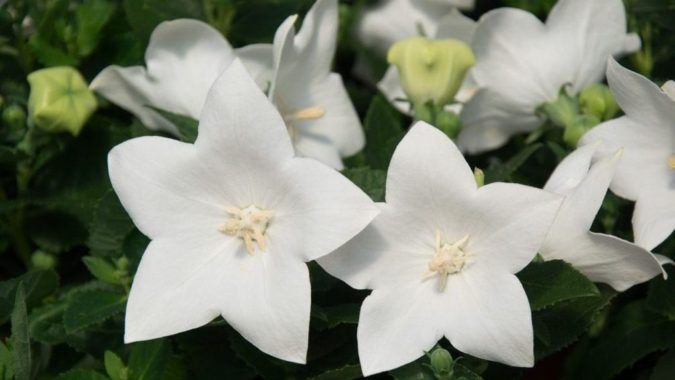

Album
Wintering plants
This type of bell has a rather fragile root system. Therefore, you should not transplant the plant from year to year - it must be left in one suitable place, and let it grow there up to 10 years.
After the plant has bloomed profusely, seed pods will appear in place of the flowers. They form around the beginning of autumn. If necessary, the seeds can be collected and left for planting next year. After that, it is necessary to cut off the stem with the peduncle.
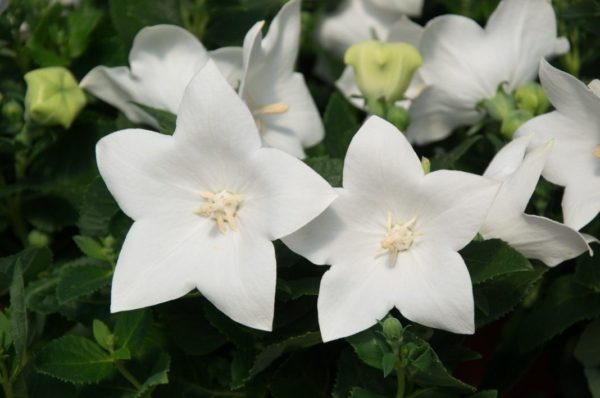

After the first frosts come, the greens will dry out - the stage will come when it is necessary to cut off all the unusable withered foliage.
In the middle lane, it is important to protect plants from winter frosts. This can be done by covering the area where the platycodon grew with a layer of mulch or yellowed foliage.So the plant will overwinter perfectly.
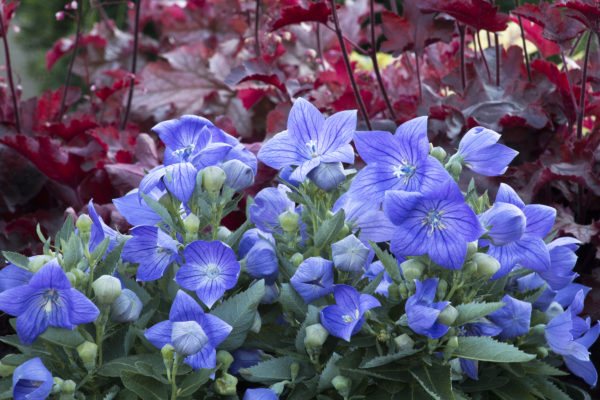

Description of platicodon
Platycodon is a herbaceous perennial plant. Each stem in height can reach from 50 to 80 cm. Near the stem are green narrow leaves, which are ovoid or elongated.
The flowers of the plant can reach about 8 cm in diameter, they are either collected in several pieces in a panicle, or grow one at a time. The palette is varied: pink, white, blue, purple. Thin veins are very clearly visible on the blue petals. The flowering of the plant begins around mid-June and lasts for the next two months.
The buds are very similar in shape to mini flashlights. The seeds are very shiny, they grow in egg-shaped capsules. The plant is often called "platikodon bell" or "shirokokolokolchik".
Using
Platycodon is used not only to decorate flower beds on the site. It is also used in folk medicine and even in cooking.
ethnoscience
Platycodon can not only decorate the garden, but also cure some diseases. Flowers are used in folk medicine. Before using a folk remedy for treatment, a consultation with a doctor is required.
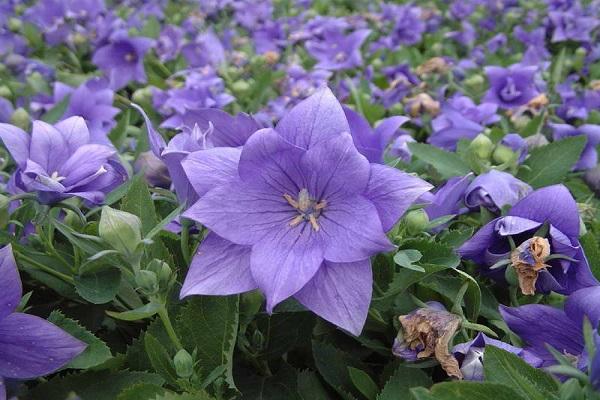

The culture is popular in Chinese traditional medicine. Rhizome is used for treatment. It contains B vitamins, phosphorus, iron, inulin, saponins and protein. It is used as an anti-inflammatory, expectorant.
Cooking
Platycodon has found applications in cooking. For example, bells can be used as decoration for desserts. The inflorescences are preliminarily sugared so that they do not dry out, and then used as decoration.
Roots are also used in cooking. They have a peculiar smell and taste a little bitter. The rhizome is used for barbecue marinade, stews, soups and vegetables.
